



















|
 |
|
 |

The Romani are argueably among the finest infantrymen in the world. With well-disciplined and high-morale heavy infantry most armies will have a problem with them in melee. As Rome was the state in antiquity which carved itself a truly world empire, their army evolved as the empire grew and this is represented in EB with reforms. The reforms are listed chronologically.
Camillan
The roman infantry of the late 4th and early 3rd century BC was divided by wealth in two groups. Those with the lowest property classification for military service were fighting as light infantry, separated by fighting ability into the Leves, Rorarii and Accensi. The second, more wealthy group consisted of those fighting as heavy infantry, separated by their age and fighting ability into Hastati, Principes, and Triarii. Every male roman had the duty to serve in the infantry for 16 years, or 20 years in the case of national emergency, until he had completed his 46th year of life. Excepting those rated high enough by the censor to be members of the ordo equester. Normally every roman must have served at least ten years in the military before he was permitted to hold any political office.
Leves (Camillan Skirmishers)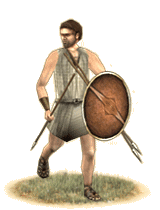 They can be recruited in the central Italian provinces Latium, Umbria, Etruria, Apulia, Liguria and Campania. These are the heartlands of the Res Publica, filled with our colonies founded during the epic struggles of the past centuries. The Leves are the legions front line skirmishers. In a pitched battle they will screen the legions main battle line during the advance and harass the enemy. Before the heavy infantry engages trumpeters signal them to retreat through the gaps in the Roman line and reform in the rear of the formation, or on the wings with the cavalry. The leves are armed with the gaesum, light javelins of Iberian style, a short thrusting spear and a small, but strong round shield. They wear no armour despite a helmet. They can be recruited in the central Italian provinces Latium, Umbria, Etruria, Apulia, Liguria and Campania. These are the heartlands of the Res Publica, filled with our colonies founded during the epic struggles of the past centuries. The Leves are the legions front line skirmishers. In a pitched battle they will screen the legions main battle line during the advance and harass the enemy. Before the heavy infantry engages trumpeters signal them to retreat through the gaps in the Roman line and reform in the rear of the formation, or on the wings with the cavalry. The leves are armed with the gaesum, light javelins of Iberian style, a short thrusting spear and a small, but strong round shield. They wear no armour despite a helmet.
Historically, the roman infantry of the late 4th and early 3rd century BC was divided by wealth in two groups. Those with the lowest property classification for military service were fighting as light infantry, separated by fighting ability into the Leves, Rorarii and Accensi. The second, more wealthy group consisted of those fighting as heavy infantry, separated by their age and fighting ability into Hastati, Principes, and Triarii. Every male roman had the duty to serve in the infantry for 16 years, or 20 years in the case of national emergency, until he had completed his 46th year of life. (Excepting those rated high enough by the censor to be members of the ordo equester.) Normally every roman must have served at least ten years in the military before he was permitted to hold any political office.
Accensi (Republican Light Reserves)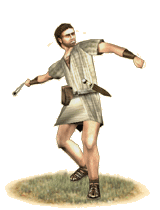 They can be recruited in the central Italian provinces Latium, Umbria, Etruria, Apulia, Liguria and Campania. These are the heartlands of the Res Publica, filled with our colonies founded during the epic struggles of the past centuries. Accensi are light reserve troops placed behind the Triarii and Rorarii in the legions battle formation. They are too poor to have any real equipment besides a sling, and in most cases too old or not experienced or skilled enough to use this effectively. Still, they are better than nothing. They can be recruited in the central Italian provinces Latium, Umbria, Etruria, Apulia, Liguria and Campania. These are the heartlands of the Res Publica, filled with our colonies founded during the epic struggles of the past centuries. Accensi are light reserve troops placed behind the Triarii and Rorarii in the legions battle formation. They are too poor to have any real equipment besides a sling, and in most cases too old or not experienced or skilled enough to use this effectively. Still, they are better than nothing.
Historically, the roman infantry of the late 4th and early 3rd century BC was divided by wealth in two groups. Those with the lowest property classification for military service were fighting as light infantry, separated by fighting ability into the Leves, Rorarii and Accensi. The second, more wealthy group consisted of those fighting as heavy infantry, separated by their age and fighting ability into Hastati, Principes, and Triarii. Every male roman had the duty to serve in the infantry for 16 years, or 20 years in the case of national emergency, until he had completed his 46th year of life. Excepting those rated high enough by the censor to be members of the ordo equester. Normally every roman must have served at least ten years in the military before he was permitted to hold any political office.
Rorarii (Camillan Reserve Skirmishers)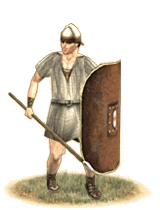 They can be recruited in the central Italian provinces Latium, Umbria, Etruria, Apulia, Liguria and Campania. These are the heartlands of the Res Publica, filled with our colonies founded during the epic struggles of the past centuries. Rorarii are reserve skirmishers that are placed behind the Triarii in the legions battle formation. They can be used to fill gaps and support wavering lines but they can't be expected to hold whole sections of the battle line by themselves.The Rorarii are armed with a hasta spear, javelins of the light Iberian gaesum type, and carry an early version of the scutum. They do not wear armour, but wear a helmet. They can be recruited in the central Italian provinces Latium, Umbria, Etruria, Apulia, Liguria and Campania. These are the heartlands of the Res Publica, filled with our colonies founded during the epic struggles of the past centuries. Rorarii are reserve skirmishers that are placed behind the Triarii in the legions battle formation. They can be used to fill gaps and support wavering lines but they can't be expected to hold whole sections of the battle line by themselves.The Rorarii are armed with a hasta spear, javelins of the light Iberian gaesum type, and carry an early version of the scutum. They do not wear armour, but wear a helmet.
Historically, the roman infantry of the late 4th and early 3rd century BC was divided by wealth in two groups. Those with the lowest property classification for military service were fighting as light infantry, separated by fighting ability into the Leves, Rorarii and Accensi. The second, more wealthy group consisted of those fighting as heavy infantry, separated by their age and fighting ability into Hastati, Principes, and Triarii. Every male roman had the duty to serve in the infantry for 16 years, or 20 years in the case of national emergency, until he had completed his 46th year of life. Excepting those rated high enough by the censor to be members of the ordo equester. Normally every roman must have served at least ten years in the military before he was permitted to hold any political office.
Hastati (Early)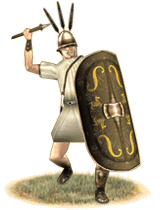 They can be recruited in the central Italian provinces Latium, Umbria, Etruria, Apulia, Liguria and Campania. These are the heartlands of the Res Publica, filled with our colonies founded during the epic struggles of the past centuries. The Hastati are the youngest soldiers that wear a full panoply and form the first of the three lines of the battle formation of legionary heavy infantry. They are expected to weaken and tire the enemy, if they cannot break him, before the next line, the Principes, engages. The strict discipline in the Roman army has become one of their keys to success. Armed with two early Etruscan pila and an Italic short sword, Hastati are protected by an early version of the scutum, a bronze helmet and a single bronze greave on the leading leg. As soon as the enemy comes in range they will throw their pila to soften his formation and then engage at close quarters. They can be recruited in the central Italian provinces Latium, Umbria, Etruria, Apulia, Liguria and Campania. These are the heartlands of the Res Publica, filled with our colonies founded during the epic struggles of the past centuries. The Hastati are the youngest soldiers that wear a full panoply and form the first of the three lines of the battle formation of legionary heavy infantry. They are expected to weaken and tire the enemy, if they cannot break him, before the next line, the Principes, engages. The strict discipline in the Roman army has become one of their keys to success. Armed with two early Etruscan pila and an Italic short sword, Hastati are protected by an early version of the scutum, a bronze helmet and a single bronze greave on the leading leg. As soon as the enemy comes in range they will throw their pila to soften his formation and then engage at close quarters.
Historically, the legion's Hastati were organised into 15 manipuli, the basic tactical unit of the Roman army. Normally the legion advanced in the famous, chessboard like, quinqunx formation. Three lines of heavy infantry with broad gaps between the single manipuli covered by the next lines displaced marching units. This practice gave the Roman army a higher maneuverability on the battlefield and made it less dependant upon the terrain than the Greek phalanx. During the battle the gaps allowed beaten or retreating units as well as fresh troops to move through the lines.
Principes (Early)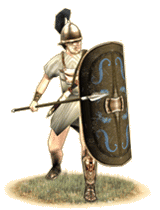 They can be recruited in the central Italian provinces Latium, Umbria, Etruria, Apulia, Liguria and Campania. These are the heartlands of the Res Publica, filled with our colonies founded during the epic struggles of the past centuries.The principes are disciplined soldiers in the prime of their life and form the second line in a legions battle formation. They engage if the Hastati are unable to break the enemy formation. Having large reserves of fresh troops available on the battlefield to engage in critical moments is one of Roman army's keys to success, besides the strict discipline. Armed with a pilum, the hasta thrusting spear, and an Italic short sword, Principes are protected by an early version of the scutum, a bronze helmet, a bronze greave on the leading leg and a small square chestplate, called pectorale, or "heart protector." As soon as the enemy comes in range they will throw their pilum to soften his formation and then engage at close quarters. They can be recruited in the central Italian provinces Latium, Umbria, Etruria, Apulia, Liguria and Campania. These are the heartlands of the Res Publica, filled with our colonies founded during the epic struggles of the past centuries.The principes are disciplined soldiers in the prime of their life and form the second line in a legions battle formation. They engage if the Hastati are unable to break the enemy formation. Having large reserves of fresh troops available on the battlefield to engage in critical moments is one of Roman army's keys to success, besides the strict discipline. Armed with a pilum, the hasta thrusting spear, and an Italic short sword, Principes are protected by an early version of the scutum, a bronze helmet, a bronze greave on the leading leg and a small square chestplate, called pectorale, or "heart protector." As soon as the enemy comes in range they will throw their pilum to soften his formation and then engage at close quarters.
Historically, the Principes of a legion were organised in 15 manipuli, the basic tactical unit of the Roman army. Normally the legion advanced in the famous, chessboard like, quinqunx formation. Three lines of heavy infantry with broad gaps between the single manipuli covered by the next lines displaced marching units. This practice gave the Roman army a higher maneuverability on the battlefield and made it less dependant upon the terrain than the Greek phalanx. During the battle the gaps allowed beaten or retreating units as well as fresh troops to move through the lines.
Triarii (Early)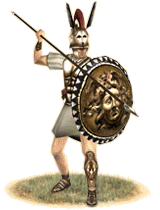 As all citizens soldiers Triarii can be recruited in the central Italian provinces Latium, Umbria, Etruria, Apulia, Liguria and Campania. These are the heartlands of the Res Publica, filled with our colonies founded during the epic struggles of the past centuries. The Triarii are the oldest and most experienced soldiers of a legion, and form the third line of heavy infantry. Most often during battle they are kept in reserve, resting on one knee under cover of their shields to stay fresh and protected until they are needed. They are the rock of the legion, covering a "rearward advance" if the heavy infantry assault failed, and an old Roman adage came of their use: "to have come to the Triarii" meant that the situation was dire, indeed. The Triarii are still equipped in full Greek panoply. They wear a muscled cuirass, a bronze greave on the leading leg, an Etrusco-Corinthian helmet, carry a Greek Clipeus shield, a hoplite sword, and the hasta thrusting spear. Thus the Triarii still continue to fight like the classical hoplite of the 5th and 4th century BC Etruscan Roman armies. After the Hastati and Principes have retreated through their line, they will form a single massive block and fight in phalanx formation, more suited to stop the enemy and stabilize the line when all hope rest on them. As all citizens soldiers Triarii can be recruited in the central Italian provinces Latium, Umbria, Etruria, Apulia, Liguria and Campania. These are the heartlands of the Res Publica, filled with our colonies founded during the epic struggles of the past centuries. The Triarii are the oldest and most experienced soldiers of a legion, and form the third line of heavy infantry. Most often during battle they are kept in reserve, resting on one knee under cover of their shields to stay fresh and protected until they are needed. They are the rock of the legion, covering a "rearward advance" if the heavy infantry assault failed, and an old Roman adage came of their use: "to have come to the Triarii" meant that the situation was dire, indeed. The Triarii are still equipped in full Greek panoply. They wear a muscled cuirass, a bronze greave on the leading leg, an Etrusco-Corinthian helmet, carry a Greek Clipeus shield, a hoplite sword, and the hasta thrusting spear. Thus the Triarii still continue to fight like the classical hoplite of the 5th and 4th century BC Etruscan Roman armies. After the Hastati and Principes have retreated through their line, they will form a single massive block and fight in phalanx formation, more suited to stop the enemy and stabilize the line when all hope rest on them.
Historically, the legion advanced in the famous, chessboard like, quinqunx formation. Three lines of heavy infantry with broad gaps between the single manipuli covered by the next lines displaced marching units. This practice gave the Roman army a higher maneuverability on the battlefield and made it less dependant upon the terrain than the Greek phalanx. During the battle the gaps allowed beaten or retreating units as well as fresh troops to move through the lines.
Eqvites Romani (Camillan Roman Citizen Cavalry)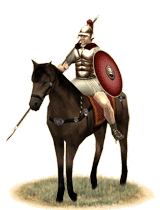 They can be recruited in the central Italian provinces Latium, Umbria, Etruria, Apulia, Liguria and Campania. These are the heartlands of the Res Publica, filled with our colonies founded during the epic struggles of the past centuries.The equites are the roman citizen cavalry force. 300 of them, divided into ten turmae, are attached to each legion. They are now armed and armoured in Greek fashion with a hasta lance, a sword, a round parma equestris shield with a diameter of 50-80 cm, a crested helmet and wear a bronze muscle cuirass. Each eques has three horses and is accompanied by two grooms. They can be recruited in the central Italian provinces Latium, Umbria, Etruria, Apulia, Liguria and Campania. These are the heartlands of the Res Publica, filled with our colonies founded during the epic struggles of the past centuries.The equites are the roman citizen cavalry force. 300 of them, divided into ten turmae, are attached to each legion. They are now armed and armoured in Greek fashion with a hasta lance, a sword, a round parma equestris shield with a diameter of 50-80 cm, a crested helmet and wear a bronze muscle cuirass. Each eques has three horses and is accompanied by two grooms.
Historically, the equites were the members of the ordo equester and the sons of the families of the ordo senatorius, the two classes of the roman nobility, the wealthiest and most influential men.
This proud horsemen were the future leading men of Roma. Their small numbers and the formidable opposition of other nations more professional cavalry often limited their effect on the battlefield, so that they were rarely used for other tasks than securing the flanks of the heavy infantry. Over many centuries the Romans had the reputation to be more willing than others to adopt new customs and techniques if they proved useful. This was seen as one of their greatest strengths. Earlier roman horsemen probably fought mainly as light cavalry with javelins until conflicts with other Italian and foreign powers heavy cavalry had taught them its effectiveness. Normally every roman must have served at least ten years in the military before he was permitted to hold any political office. The eques had the duty to serve ten years, the infantryman 16 or 20 years in the case of national emergency, until he has completed his 46 year of life.
Pedites Extraordinarii (Elite Heavy Infantry of the Italic Allies)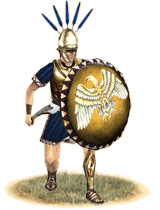 The consuls can enroll the troops of the socii in all regions of Italia. In a consular army the best fifth of the socii infantry and a third of their cavalry are selected to serve as extraordinarii, a special unit under the direct control of the consul, available for decisive manoeuvres. On the march they are the advance or rear guard, defending the army against possible attacks. Especially the Samnites are famous for their heavy infantry and many of them are picked to serve as pedites extraordinarii. The consuls can enroll the troops of the socii in all regions of Italia. In a consular army the best fifth of the socii infantry and a third of their cavalry are selected to serve as extraordinarii, a special unit under the direct control of the consul, available for decisive manoeuvres. On the march they are the advance or rear guard, defending the army against possible attacks. Especially the Samnites are famous for their heavy infantry and many of them are picked to serve as pedites extraordinarii.
They fight in a similar manner than the ordinary roman legionary with javelins and swords but besides their native traditions the soldier's equipment is more influenced by greek fashions. with a bronze muscle cuirass, a helmet, a hoplon style shield, several light javelins and a kopis sword.
Historically, Italy was inhabited by many proven people that could field their own powerful heavy infantry equal to the contemporary legions. After they had been subdued by Roma they became socii ,the Italic allies of the Romani, and now had to provide troops for their wars. Most respected was the infantry of the Samnites, proud warriors with their own strong military traditions who had heavily influenced the development of roman manipular warfare in the third century BC. They were a group of tribes that inhabited Samnium, a mountainous region in the southern part of the Apennines in central Italy. Long time they could successfully rival the roman hegemony over central Italy. The Romans had to fight three changeful wars against them between 343 BC and 290 BC when Samnium finally lost its independence. However their strong antipathy against the Romans did not disappear. On many occasions the Samnites rebelled or fought with Roma's enemies until they were defeated a last time in the social war. After high looses the survivors received roman citizenship and were assimilated into the roman state. When a roman army was enrolled the socii were ordered to sent troops as well and to join the roman forces on a selected place. Usually their infantry equalled that of the Romans while their cavalry was three times as numerous. In a standard consular two legion army the remainder of their troops, without the extraordinarii, were divided into two equal sized units. Called ala sinistra and ala dextera (left and right wing) for being placed on the flanks of the similar sized legions. After the social war their distinctive units finally disappeared when most people of Italia received full citizenship and were now directly recruited into the legions.
Eqvites Extraordinarii (Elite Heavy Cavalry of the Italic Allies)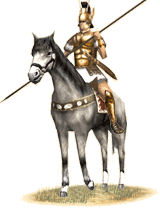 The consuls can enroll the troops of the socii in all regions of Italia.In a standard consular army the best third of socii's cavarly and the best fifth of their infantry are selected to serve as Extraordinarii, a special unit under the direct control of the consul, available for decisive manoeuvres. On the march they are the advance or rear guard, defending the army against possible attacks. The consuls can enroll the troops of the socii in all regions of Italia.In a standard consular army the best third of socii's cavarly and the best fifth of their infantry are selected to serve as Extraordinarii, a special unit under the direct control of the consul, available for decisive manoeuvres. On the march they are the advance or rear guard, defending the army against possible attacks.
Equites Extraordinarii are the finest horsemen Italia can field, mostly drawn from the aristocracy of the horse breeding regions. Especially campanian cavalry proved to be a valuable addition for every roman army and many of them were picked as Equites Extraordinarii. Armed with Greek xyston lances and kopis slashing swords, they normally fight as shock cavalry, spared in battle for the decisive attack. To show their position in society most riders wear elaborately decorated armour, mainly bronze muscle cuirasses, attic helmets and greaves.
Historically, quite a few regions of the Italian peninsula were well suited for horse breeding and their aristocracy provided the bulk of the cavalry for the roman armies. Especially the horsemen from Campania, that came under Roman rule in the 4th century BC were famous for their qualities. The campanian's large horses and their well trained riders, coming from an equestrian nobility with its own strong traditions, made them the one of the most respected cavalry in Italy. The structure of the roman society and the position of the ordo equester as part of the leading classes made it impossible to supply the armies of the Res Publica with a sufficient number of citizen cavalry, so the socii, the Italic allies of the Romani, and their horsemen had to fill the gap. In roman service every eques sociorum had two horses and was accompanied by a groom. When a republican roman army was enrolled the socii were ordered to sent troops as well and to join the roman forces on a selected place. Usually their infantry equalled that of the Romans while their cavalry was three times as numerous. In a standard consular two legion army the remainder of their troops, without the extraordinarii, were divided into two equal sized units. Called ala sinistra and ala dextera (left and right wing) for being placed on the flanks of the similar sized legions. During the 2nd century BC non Italic auxiliary cavalry increasingly replaced the socii as the dominant part of most armies mounted contingent and after the social war their distinctive units disappeared when most inhabitants of Italia received full citizenship and were directly recruited into the legions.
Hastati Samnitici (Allied Samnite Medium Spearmen)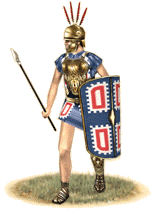 The Samnites come from the Apennine highlands of central and southern Italy. They have a military tradition as old as Rome itself. They were an expansionistic people until they were forcibly put down, for the last time in the 290’s BC. Their flexible formations were ideal to fight in rough terrain and the Romans eventually copied and improved them after having felt their effectiveness first-hand. These Samnite Spearmen are dependable medium infantry carrying light javelins that they throw before an ensuing melee with their spears. They are well armored with bronze breastplates and helms and have a single greave on their left leg (the leg most vulnerable in hand to hand combat). Although not a shock unit as their swordsmen counterpart, they are well trained, fast and reliable spearmen. They are not capable of standing up to professional heavy infantry, but their spears, bronze breastplates and large shields make them suited to fighting against quite a few infantry and light and medium cavalry types. The Samnites come from the Apennine highlands of central and southern Italy. They have a military tradition as old as Rome itself. They were an expansionistic people until they were forcibly put down, for the last time in the 290’s BC. Their flexible formations were ideal to fight in rough terrain and the Romans eventually copied and improved them after having felt their effectiveness first-hand. These Samnite Spearmen are dependable medium infantry carrying light javelins that they throw before an ensuing melee with their spears. They are well armored with bronze breastplates and helms and have a single greave on their left leg (the leg most vulnerable in hand to hand combat). Although not a shock unit as their swordsmen counterpart, they are well trained, fast and reliable spearmen. They are not capable of standing up to professional heavy infantry, but their spears, bronze breastplates and large shields make them suited to fighting against quite a few infantry and light and medium cavalry types.
Historically the Samnites were one of the most rebellious Italian peoples and joined up with Rome’s enemies on a regular basis. They fought with Pyrrus in the 290’s, rose up in rebellion during the first Punic War, and fought alongside Hannibal in the second Punic War. They rose a final time during the Italian Social Wars, and were incorporated into the Roman state by receiving Roman citizenship. They still fought with their distinctive bronze belts until the middle empire, and even then legions from Samnium still had the national symbol of their former country on their shields.
Samnitici Milites (Samnite Heavy Infantry)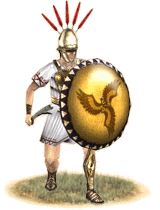 The Samnites come from the Apennine highlands of central and southern Italy. They have a military tradition as old as Rome itself. They were an expansionistic people until they were forcibly put down, for the last time in the 290’s BC. They have a fine tradition of fast heavy infantry that is very different from the Romans and from their southern Italian neighbors. Their infantry carries lighter javelins (and consequently more of them) and is armed with the Greek Kopis, a slashing sword that is very powerful and can be used against armor due to its shape (and is much like the Iberian Falcata). These Samnites are well armored with bronze breastplates, helms, greaves, and a round argive shield. Although not as disciplined as Roman infantry, they are trained to a high degree and make up for their indiscipline with their fighting style and fierce hatred of their Roman foe. Some Samnite tribes have broken with their brothers in Samnium and now work for the Romans. Others long for the day when an enemy of Rome will come to Italy so that they can flock to the fight against their hated foes… The Samnites come from the Apennine highlands of central and southern Italy. They have a military tradition as old as Rome itself. They were an expansionistic people until they were forcibly put down, for the last time in the 290’s BC. They have a fine tradition of fast heavy infantry that is very different from the Romans and from their southern Italian neighbors. Their infantry carries lighter javelins (and consequently more of them) and is armed with the Greek Kopis, a slashing sword that is very powerful and can be used against armor due to its shape (and is much like the Iberian Falcata). These Samnites are well armored with bronze breastplates, helms, greaves, and a round argive shield. Although not as disciplined as Roman infantry, they are trained to a high degree and make up for their indiscipline with their fighting style and fierce hatred of their Roman foe. Some Samnite tribes have broken with their brothers in Samnium and now work for the Romans. Others long for the day when an enemy of Rome will come to Italy so that they can flock to the fight against their hated foes…
Historically the Samnites were one of the most rebellious Italian peoples and joined up with Rome’s enemies on a regular basis. They fought with Pyrrus in the 290’s, rose up in rebellion during the first Punic War, and fought alongside Hannibal in the second Punic War. They rose a final time during the Italian Social Wars, and were incorporated into the Roman state by receiving Roman citizenship. They still fought with their distinctive bronze belts until the middle empire, and even then legions from Samnium still had the national symbol of their former country on their shields.
Polybian
Over many centuries the Romans had the reputation to be more willing than others to adopt new customs and techniques if they proved useful. This was seen as one of their greatest strengths. The Montefortino Helmet was probably of Celtic origin and was adapted during the 3rd Century BC conflicts. Every male roman had the duty to serve in the infantry for 16 years, or 20 years in the case of national emergency, until he had completed his 46th year of life. Excepting those rated high enough by the censor to be members of the ordo equester or those rated with less than 400 drachmae worth of property, who have to serve in the fleet. Normally every roman must have served at least ten years in the military before he was permitted to hold any political office.
Velites (Polybian Skirmishers)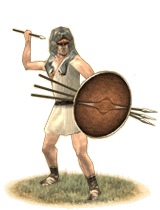 They can be recruited all Italian homeland provinces, the central heartlands of the Res Publica as well as the recently colonised areas in the south and the Po valley. Velites are the legions light infantry. In a pitched battle they will screen the legions main battle line during the advance and harass the enemy. Before the heavy infantry engages trumpeters signal them to retreat through the gaps in the Roman line and reform behind the Triarii, or on the wings with the cavalry. Sometimes they are also directly used to support the cavalry. The Velites are armed with javelins, a short sword and a small, but strong round shield. They wear no armour besides a plain helmet covered with an animal's skin (usually that of a wolf). This is mainly used for identification, and to make individuals recognizable to the centurions and tribunes over great distances. They can be recruited all Italian homeland provinces, the central heartlands of the Res Publica as well as the recently colonised areas in the south and the Po valley. Velites are the legions light infantry. In a pitched battle they will screen the legions main battle line during the advance and harass the enemy. Before the heavy infantry engages trumpeters signal them to retreat through the gaps in the Roman line and reform behind the Triarii, or on the wings with the cavalry. Sometimes they are also directly used to support the cavalry. The Velites are armed with javelins, a short sword and a small, but strong round shield. They wear no armour besides a plain helmet covered with an animal's skin (usually that of a wolf). This is mainly used for identification, and to make individuals recognizable to the centurions and tribunes over great distances.
Historically, the Velites were the men who were either too young to fight as Hastati or to poor to pay for equipment. They are all what had remained from the various Roman light infantry classes of the late 4th and early 3rd century BC, replacing the function of the Leves. The roughly 1200 Velites in a legion were not organised in their own manipuli with own officers, instead 20 of them were attached to each manipuli of the other infantry classes. Every male roman had the duty to serve in the infantry for 16 years, or 20 years in the case of national emergency, until he had completed his 46th year of life. Excepting those rated high enough by the censor to be members of the ordo equester, or those with less than 400 drachmae worth of property who must serve in the fleet. Normally every roman must have served at least ten years in the military before he was permitted to hold any political office.
Hastati (Late)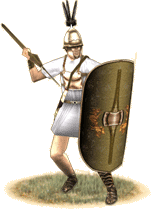 They can be recruited all Italian homeland provinces, the central heartlands of the Res Publica as well as the recently colonised areas in the south and the Po valley. The Hastati are the youngest soldiers that wear a full panoply and form the first of the three lines in a legions battle formation. They are expected to weaken and tire the enemy if they cannot break him, before the next line of the Principes engages. Armed with two pila and a gladius, Hastati are protected by a scutum, a bronze Montefortino helmet, a bronze greave on the leading leg and a mostly square chestplate, called pectorale or "heart protector." As soon as the enemy comes in range they will throw their pila to soften his formation and then engage at close quarters. The high quality equipment has become one of the great strengths of the Roman infantry, besides their strict discipline. The scutum is an oval, canvas covered, plywood shield, around 1.2m high, that offers excellent protection against most weapons. The gladius hispaniensis, adapted during the late 3rd century BC conflicts, is a great weapon for fighting in close formations. Its strong, unbending blade has a sharp point to penetrate heavy armour and can deal an effective blow with both edges. So it can be used for stabbing or slashing as well. The pilum, the heavy Roman javelin, is designed to bend after impact so that it is worthless for the enemy and is difficult to remove from shields. Its weight also gives the weapon great penetration capability. They can be recruited all Italian homeland provinces, the central heartlands of the Res Publica as well as the recently colonised areas in the south and the Po valley. The Hastati are the youngest soldiers that wear a full panoply and form the first of the three lines in a legions battle formation. They are expected to weaken and tire the enemy if they cannot break him, before the next line of the Principes engages. Armed with two pila and a gladius, Hastati are protected by a scutum, a bronze Montefortino helmet, a bronze greave on the leading leg and a mostly square chestplate, called pectorale or "heart protector." As soon as the enemy comes in range they will throw their pila to soften his formation and then engage at close quarters. The high quality equipment has become one of the great strengths of the Roman infantry, besides their strict discipline. The scutum is an oval, canvas covered, plywood shield, around 1.2m high, that offers excellent protection against most weapons. The gladius hispaniensis, adapted during the late 3rd century BC conflicts, is a great weapon for fighting in close formations. Its strong, unbending blade has a sharp point to penetrate heavy armour and can deal an effective blow with both edges. So it can be used for stabbing or slashing as well. The pilum, the heavy Roman javelin, is designed to bend after impact so that it is worthless for the enemy and is difficult to remove from shields. Its weight also gives the weapon great penetration capability.
Historically, the legions 1200 Hastati were organised in ten manipuli, the basic tactical unit of the Roman army. Normally the legion advanced in the famous, chessboard like, quinqunx formation. Three lines of heavy infantry with broad gaps between the single manipuli covered by the next lines displaced marching units. This practice gave the Roman army a higher maneuverability on the battlefield and made it less dependant upon the terrain than the Greek phalanx. During the battle the gaps allowed beaten or retreating units as well as fresh troops to move through the lines.
Principes (Late)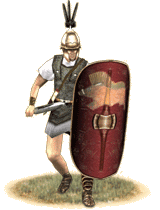 They can be recruited all Italian homeland provinces, the central heartlands of the Res Publica as well as the recently colonised areas in the south and the Po valley. The Principes are the soldiers in the prime of their life and form the second line in a legion's battle formation. They will engage if the Hastati were unable to break the enemy formations. Having large reserves of fresh troops available on the battlefield to engage in critical moments is one of the Roman army's keys to success. Armed with two pila and a gladius, the Principes are protected by a scutum, a bronze Montefortino helmet, a bronze greave on the leading leg and now mostly by a coat of lorica hamata (chain mail). As soon as the enemy comes in range they will throw their pila to soften his formation and then engage at close quarters. The high quality equipment has become one of the great strengths of the Roman infantry, besides their strict discipline. The scutum is an oval, canvas covered, plywood shield, around 1.2m high, that offers excellent protection against most weapons. The gladius hispaniensis, adapted during the late 3rd century BC conflicts, is a great weapon for fighting in close formations. Its strong, unbending blade has a sharp point to penetrate heavy armour and can deal an effective blow with both edges. So it can be used for stabbing or slashing as well. The pilum, the heavy Roman javelin, is designed to bend after impact so that it is worthless for the enemy and is difficult to remove from shields. Its weight also gives the weapon great penetration capability. They can be recruited all Italian homeland provinces, the central heartlands of the Res Publica as well as the recently colonised areas in the south and the Po valley. The Principes are the soldiers in the prime of their life and form the second line in a legion's battle formation. They will engage if the Hastati were unable to break the enemy formations. Having large reserves of fresh troops available on the battlefield to engage in critical moments is one of the Roman army's keys to success. Armed with two pila and a gladius, the Principes are protected by a scutum, a bronze Montefortino helmet, a bronze greave on the leading leg and now mostly by a coat of lorica hamata (chain mail). As soon as the enemy comes in range they will throw their pila to soften his formation and then engage at close quarters. The high quality equipment has become one of the great strengths of the Roman infantry, besides their strict discipline. The scutum is an oval, canvas covered, plywood shield, around 1.2m high, that offers excellent protection against most weapons. The gladius hispaniensis, adapted during the late 3rd century BC conflicts, is a great weapon for fighting in close formations. Its strong, unbending blade has a sharp point to penetrate heavy armour and can deal an effective blow with both edges. So it can be used for stabbing or slashing as well. The pilum, the heavy Roman javelin, is designed to bend after impact so that it is worthless for the enemy and is difficult to remove from shields. Its weight also gives the weapon great penetration capability.
Historically, the legion's 1200 Principes were organised in ten manipuli, the basic tactical unit of the Roman army. Normally the legion advanced in the famous, chessboard like, quinqunx formation. Three lines of heavy infantry with broad gaps between the single manipuli covered by the next lines displaced marching units. This practice gave the Roman army a higher maneuverability on the battlefield and made it less dependant upon the terrain than the Greek phalanx. During the battle the gaps allowed beaten or retreating units as well as fresh troops to move through the lines.
Triarii (Late)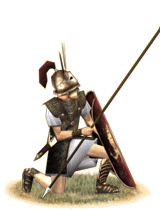 They can be recruited all Italian homeland provinces, the central heartlands of the Res Publica as well as the recently colonised areas in the south and the Po valley. The 600 Triarii are the oldest and most experienced soldiers of the legion, forming its last reserve, the third line. Most often during battle they rest in reserve on one knee, under cover of their shields, to stay fresh and protected until they are needed. They are the rock of the legion, covering a "rearward advance" if the heavy infantry assault fails, and an old Roman adage came of their use: "to have come to the Triarii" meant that the situation was dire, indeed. Armed with a hasta thrusting spear and a gladius, Triarii are protected by a scutum, a bronze Montefortino helmet, a bronze greave on the leading leg and now mostly by a coat of lorica hamata (chain mail). They continue to fight with long hasta spears in a close formation more suited to stop the enemy and stabilize the line if all hope rest on them.The high quality equipment has become one of the great strengths of the Roman infantry, besides their strict discipline. The scutum is an oval, canvas covered, plywood shield, around 1.2m high, that offers excellent protection against most weapons. The gladius hispaniensis, adapted during the late 3rd century BC conflicts, is a great weapon for fighting in close formations. Its strong, unbending blade has a sharp point to penetrate heavy armour and can deal an effective blow with both edges. So it can be used for stabbing or slashing as well. The pilum, the heavy Roman javelin, is designed to bend after impact so that it is worthless for the enemy and is difficult to remove from shields. Its weight also gives the weapon great penetration capability. They can be recruited all Italian homeland provinces, the central heartlands of the Res Publica as well as the recently colonised areas in the south and the Po valley. The 600 Triarii are the oldest and most experienced soldiers of the legion, forming its last reserve, the third line. Most often during battle they rest in reserve on one knee, under cover of their shields, to stay fresh and protected until they are needed. They are the rock of the legion, covering a "rearward advance" if the heavy infantry assault fails, and an old Roman adage came of their use: "to have come to the Triarii" meant that the situation was dire, indeed. Armed with a hasta thrusting spear and a gladius, Triarii are protected by a scutum, a bronze Montefortino helmet, a bronze greave on the leading leg and now mostly by a coat of lorica hamata (chain mail). They continue to fight with long hasta spears in a close formation more suited to stop the enemy and stabilize the line if all hope rest on them.The high quality equipment has become one of the great strengths of the Roman infantry, besides their strict discipline. The scutum is an oval, canvas covered, plywood shield, around 1.2m high, that offers excellent protection against most weapons. The gladius hispaniensis, adapted during the late 3rd century BC conflicts, is a great weapon for fighting in close formations. Its strong, unbending blade has a sharp point to penetrate heavy armour and can deal an effective blow with both edges. So it can be used for stabbing or slashing as well. The pilum, the heavy Roman javelin, is designed to bend after impact so that it is worthless for the enemy and is difficult to remove from shields. Its weight also gives the weapon great penetration capability.
Historically the Triarii were also divided into ten maniples, but each was half the size of those containing Hastati or Principes. Normally the legion advanced in the famous, chessboard like, quinqunx formation. Three lines of heavy infantry with broad gaps between the single manipuli covered by the next lines displaced marching units. This practice gave the Roman army a higher maneuverability on the battlefield and made it less dependant upon the terrain than the Greek phalanx. During the battle the gaps allowed beaten or retreating units as well as fresh troops to move through the lines.
Eqvites Romani (Polybian Roman Citizen Cavalry)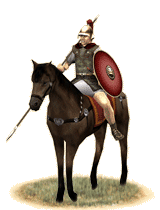 They can be recruited all Italian homeland provinces, the central heartlands of the Res Publica as well as the recently colonised areas in the south and the Po valley.
The equites are the roman citizen cavalry force. 300 of them, divided into ten turmae, are attached to each legion. They are equipped with a hasta lance, a sword, a round parma equestris shield with a diameter of 50-80 cm, thessalian helmets and wear lorica hamata (chainmail). Each eques has three horse and is accompanied by two grooms. They can be recruited all Italian homeland provinces, the central heartlands of the Res Publica as well as the recently colonised areas in the south and the Po valley.
The equites are the roman citizen cavalry force. 300 of them, divided into ten turmae, are attached to each legion. They are equipped with a hasta lance, a sword, a round parma equestris shield with a diameter of 50-80 cm, thessalian helmets and wear lorica hamata (chainmail). Each eques has three horse and is accompanied by two grooms.
Historically, the equites were the members of the ordo equester and the sons of the families of the ordo senatorius, the two classes of the roman nobility, the wealthiest and most influential men. The rise of Roma had brought both, an increasing number of wealthy and influential citizens and an increased need for more cavalry for the growing number of legions. Since the middle republic the ordo equester itself was divided between the 1800 equites equo publico, the original and true equites romani, which fought on mounts provided by the state and the less respected equites equo privato, who fought on their own horses.
This proud horsemen were the future leading men of Roma. Their small numbers and the formidable opposition of other nations more professional cavalry often limited their effect on the battlefield, so that they were rarely used for other tasks than securing the flanks of the heavy infantry. Over many centuries the Romans had the reputation to be more willing than others to adopt new customs and techniques if they proved useful. This was seen as one of their greatest strengths. The chain mail armour was probably of Celtic origin and adapted during the late 3rd century BC conflicts.Normally every roman must have served at least ten years in the military before he was permitted to hold any political office. The eques had the duty to serve ten years, the infantryman 16 or 20 years in the case of national emergency, until he has completed his 46 year of life.
Pedites Extraordinarii (Elite Heavy Infantry of the Italic Allies) The consuls can enroll the troops of the socii in all regions of Italia. In a consular army the best fifth of the socii infantry and a third of their cavalry are selected to serve as extraordinarii, a special unit under the direct control of the consul, available for decisive manoeuvres. On the march they are the advance or rear guard, defending the army against possible attacks. Especially the Samnites are famous for their heavy infantry and many of them are picked to serve as pedites extraordinarii. The consuls can enroll the troops of the socii in all regions of Italia. In a consular army the best fifth of the socii infantry and a third of their cavalry are selected to serve as extraordinarii, a special unit under the direct control of the consul, available for decisive manoeuvres. On the march they are the advance or rear guard, defending the army against possible attacks. Especially the Samnites are famous for their heavy infantry and many of them are picked to serve as pedites extraordinarii.
They fight in a similar manner than the ordinary roman legionary with javelins and swords but besides their native traditions the soldier's equipment is more influenced by greek fashions. with a bronze muscle cuirass, a helmet, a hoplon style shield, several light javelins and a kopis sword.
Historically, Italy was inhabited by many proven people that could field their own powerful heavy infantry equal to the contemporary legions. After they had been subdued by Roma they became socii ,the Italic allies of the Romani, and now had to provide troops for their wars. Most respected was the infantry of the Samnites, proud warriors with their own strong military traditions who had heavily influenced the development of roman manipular warfare in the third century BC. They were a group of tribes that inhabited Samnium, a mountainous region in the southern part of the Apennines in central Italy. Long time they could successfully rival the roman hegemony over central Italy. The Romans had to fight three changeful wars against them between 343 BC and 290 BC when Samnium finally lost its independence. However their strong antipathy against the Romans did not disappear. On many occasions the Samnites rebelled or fought with Roma's enemies until they were defeated a last time in the social war. After high looses the survivors received roman citizenship and were assimilated into the roman state. When a roman army was enrolled the socii were ordered to sent troops as well and to join the roman forces on a selected place. Usually their infantry equalled that of the Romans while their cavalry was three times as numerous. In a standard consular two legion army the remainder of their troops, without the extraordinarii, were divided into two equal sized units. Called ala sinistra and ala dextera (left and right wing) for being placed on the flanks of the similar sized legions. After the social war their distinctive units finally disappeared when most people of Italia received full citizenship and were now directly recruited into the legions.
Eqvites Extraordinarii (Elite Heavy Cavalry of the Italic Allies) The consuls can enroll the troops of the socii in all regions of Italia.In a standard consular army the best third of socii's cavarly and the best fifth of their infantry are selected to serve as Extraordinarii, a special unit under the direct control of the consul, available for decisive manoeuvres. On the march they are the advance or rear guard, defending the army against possible attacks. The consuls can enroll the troops of the socii in all regions of Italia.In a standard consular army the best third of socii's cavarly and the best fifth of their infantry are selected to serve as Extraordinarii, a special unit under the direct control of the consul, available for decisive manoeuvres. On the march they are the advance or rear guard, defending the army against possible attacks.
Equites Extraordinarii are the finest horsemen Italia can field, mostly drawn from the aristocracy of the horse breeding regions. Especially campanian cavalry proved to be a valuable addition for every roman army and many of them were picked as Equites Extraordinarii. Armed with Greek xyston lances and kopis slashing swords, they normally fight as shock cavalry, spared in battle for the decisive attack. To show their position in society most riders wear elaborately decorated armour, mainly bronze muscle cuirasses, attic helmets and greaves.
Historically, quite a few regions of the Italian peninsula were well suited for horse breeding and their aristocracy provided the bulk of the cavalry for the roman armies. Especially the horsemen from Campania, that came under Roman rule in the 4th century BC were famous for their qualities. The campanian's large horses and their well trained riders, coming from an equestrian nobility with its own strong traditions, made them the one of the most respected cavalry in Italy. The structure of the roman society and the position of the ordo equester as part of the leading classes made it impossible to supply the armies of the Res Publica with a sufficient number of citizen cavalry, so the socii, the Italic allies of the Romani, and their horsemen had to fill the gap. In roman service every eques sociorum had two horses and was accompanied by a groom. When a republican roman army was enrolled the socii were ordered to sent troops as well and to join the roman forces on a selected place. Usually their infantry equalled that of the Romans while their cavalry was three times as numerous. In a standard consular two legion army the remainder of their troops, without the extraordinarii, were divided into two equal sized units. Called ala sinistra and ala dextera (left and right wing) for being placed on the flanks of the similar sized legions. During the 2nd century BC non Italic auxiliary cavalry increasingly replaced the socii as the dominant part of most armies mounted contingent and after the social war their distinctive units disappeared when most inhabitants of Italia received full citizenship and were directly recruited into the legions.
Eqvites Consvlares (Republican Consular Guard Cavalry)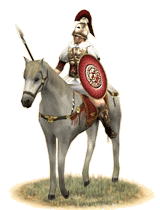 Consuls, and other high Roman officials, are escorted by small mounted bodyguards. Most of these horsemen share a similar background and strong social ties with their general, and loyally fight with him as heavy cavalry.Magnificent, prestigious Greek armour is predominantly used by the Equites Consulares. Most of them wear shining bronze muscle cuirasses, Etrusco-Corinthian helmets, and greaves on both legs. Besides the traditional Roman round parma equestris shield they carry a hasta lance and swords as weapons. Each eques has at least three horses and is accompanied by two grooms. Consuls, and other high Roman officials, are escorted by small mounted bodyguards. Most of these horsemen share a similar background and strong social ties with their general, and loyally fight with him as heavy cavalry.Magnificent, prestigious Greek armour is predominantly used by the Equites Consulares. Most of them wear shining bronze muscle cuirasses, Etrusco-Corinthian helmets, and greaves on both legs. Besides the traditional Roman round parma equestris shield they carry a hasta lance and swords as weapons. Each eques has at least three horses and is accompanied by two grooms.
Historically, during campaigns, the consuls and other leading men of the res publica were accompanied by a group of voluntarii. Personal friends, veterans of former commands or clients, most of them also from the higher classes of Roman society, acting as a bodyguard in the field. The equites were the members of the ordo equester and the sons of the families of the ordo senatorius, the two classes of the Roman nobility, the wealthiest and most influential men. These proud horsemen were the future leading men of Roma. Normally every Roman must have served at least ten years in the military before he was permitted to hold any political office. The eques had the duty to serve ten years, the infantryman 16 or 20 years in the case of national emergency, until he has completed his 46th year of life.
Marian
Antesignani (Post Marian Elite Legionary Light Infantry)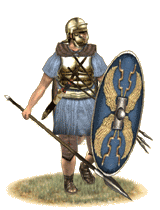 Besides the regions of Italia, that now have collectively gained citizenship, they can be recruited in all fully Romanized provinces of the Imperium Romanum, where great numbers of our citizens have now their home. Antesignani are elite legionaries trained to fight outside the heavy infantry's battle formation. Armed with spears, several light javelins, and a gladius they are more lightly armoured with a simple bronze breastplate instead of lorica hamata, a new Coolus bronze helmet, and carry smaller oval shields instead the heavy scuta to increase their agility. On march the duties of the Antesignani are to cover the columns as well as to scout and secure the area in front of the army. In a battle they can be used to screen the legions advance, to counter enemy skirmishers, or to support the cavalry if no specialised auxiliaries are available. Besides the regions of Italia, that now have collectively gained citizenship, they can be recruited in all fully Romanized provinces of the Imperium Romanum, where great numbers of our citizens have now their home. Antesignani are elite legionaries trained to fight outside the heavy infantry's battle formation. Armed with spears, several light javelins, and a gladius they are more lightly armoured with a simple bronze breastplate instead of lorica hamata, a new Coolus bronze helmet, and carry smaller oval shields instead the heavy scuta to increase their agility. On march the duties of the Antesignani are to cover the columns as well as to scout and secure the area in front of the army. In a battle they can be used to screen the legions advance, to counter enemy skirmishers, or to support the cavalry if no specialised auxiliaries are available.
Historically, the organization of the legion began to change at the end of the 2nd century BC and in the early 1st century BC all but the heavy infantry had disappeared. The Hastati, Principes and Triarii were now all equipped in the same manner and only their names remained. Three of their maniples, each increased in size to 160 men, now formed one cohort, the new main tactical unit of the Roman infantry, besides the now 80 men strong centuria. These changes offered much more tactical flexibility to the legion. Instead of being limited to a three line battle formation, the soldiers could be positioned as easily in one, two or even more lines. A cohort was big enough to operate separated from the main army, to perform smaller tasks independently. After the social war the former socii received Roman citizenship and were now recruited into the legions. However, the disappearance of the Velites and Pedites Extraordinarii reduced the legion's abilities and made it dependent upon external light infantry support. In the 1st century BC it became common to train some elite legionaries as Antesignani to fill this gap. The problem of the late republic to find enough men who fulfilled the property requirements to serve as heavy infantry in the many and continuous wars the masters of the Mediterranean world now had to fight was one of the main reasons that reforms in the army had become inevitable. Earlier attempts to increase to the number of suitable small farmers through land reforms by the gracchi were blocked by senate, as many senators owned great latifundia now sprawling over Italy, by themselves. So all property requirements were given up and volunteers from all social classes were welcomed as well as the conscripts, while the state or their generals paid for their equipment. The senate had refused to bear the incalculable able costs for the veterans so that the generals had to take care of them. The loyalty of these men shifted more and more to charismatic leaders , they were now depending on, preparing the ground for many bloody civil wars of the 1st century BC.
Cohors Reformata (Post Marian Legionary Cohort)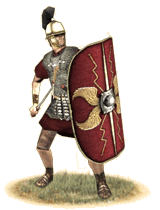 Besides the regions of Italia, that now have collectively gained citizenship, they can be recruited in all fully Romanized provinces of the Imperium Romanum, where great numbers of our citizens have now their home. Roman legionaries are now uniformly equipped with two pila, a gladius, and an elliptical scutum around 1.28m high. Their main armour still remains a coat of lorica hamata (chain mail) and a Montefortino-type helmet. The high quality of the legions equipment has become one of the great strengths of the Roman infantry, besides their strict discipline. In battle they will throw their pila as soon as the enemy comes in range to soften his formation and then engage at close quarters. Besides the regions of Italia, that now have collectively gained citizenship, they can be recruited in all fully Romanized provinces of the Imperium Romanum, where great numbers of our citizens have now their home. Roman legionaries are now uniformly equipped with two pila, a gladius, and an elliptical scutum around 1.28m high. Their main armour still remains a coat of lorica hamata (chain mail) and a Montefortino-type helmet. The high quality of the legions equipment has become one of the great strengths of the Roman infantry, besides their strict discipline. In battle they will throw their pila as soon as the enemy comes in range to soften his formation and then engage at close quarters.
Historically, the organization of the legion began to change at the end of the 2nd century BC and in the early 1st century BC all but the heavy infantry had disappeared. The Hastati, Principes and Triarii were now all equipped in the same manner and only their names remained. Three of their maniples, each increased in size to 160 men, now formed one cohort, the new main tactical unit of the Roman infantry, besides the now 80 men strong centuria. However, in most times the late republican legions did not reach their theoretical strength, and around 400 men per cohort was far more common. These changes offered much more tactical flexibility to the legion. Instead of being limited to a three line battle formation, the soldiers could be positioned as easily in one, two, or even more lines. A cohort was big enough to operate separated from the main army, to perform smaller tasks independently. To reduce the legion's vulnerable baggage train and increase the mobility of the troops, the legionaries now had to carry as much of their equipment as possible by themselves. They received the nickname "mules mariani", the "mules of Marius," for the nearly 50 Kg they carried. The long time they normally had to serve made it possible to train all soldiers to an equally high standard in the whole army. This, and the heavy load they have to carry, gave them their unrivalled endurance. Experts in siege warfare, artillery, and other engineering tasks could be found in the ranks of the legion, and all contubernia, the eight men strong basic logistical unit of the army, were equipped with tools and valli for the fast construction of field fortifications. After these changes the Roman legionnaires could easily be considered the most disciplined and most versatile heavy infantry in the world. The problem of the late republic to find enough men who fulfilled the property requirements to serve as heavy infantry in the many and continuous wars the masters of the Mediterranean world now had to fight was one of the main reasons that reforms in the army had become inevitable. Earlier attempts to increase to the number of suitable small farmers through land reforms by the gracchi were blocked by senate, as many senators owned great latifundia now sprawling over Italy, by themselves. So all property requirements were given up and volunteers from all social classes were welcomed as well as the conscripts, while the state or their generals paid for their equipment. The senate had refused to bear the incalculable able costs for the veterans so that the generals had to take care of them. The loyalty of these men shifted more and more to charismatic leaders , they were now depending on, preparing the ground for many bloody civil wars of the 1st century BC.
Cohors Evocata (Post Marian Reenlisted Veterans Cohort)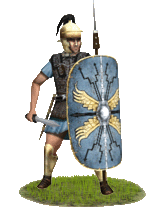 Until very recently most veterans of the legions were settled down in Italia after their discharge. Here they can be found if you need their service again. A Cohors Evocata consist of former legionaries that have reenlisted again, forming now a veteran corps within the army. They are liberated from the many routine duties of a normal soldier and their weapons and armour are of high quality. Besides a an oval scutum, Evocati wear a suit of lorica hamata (chain mail), the new Coolus bronze helmet and two greaves for protection and are fighting like normal legionaries with a gladius and pila. Until very recently most veterans of the legions were settled down in Italia after their discharge. Here they can be found if you need their service again. A Cohors Evocata consist of former legionaries that have reenlisted again, forming now a veteran corps within the army. They are liberated from the many routine duties of a normal soldier and their weapons and armour are of high quality. Besides a an oval scutum, Evocati wear a suit of lorica hamata (chain mail), the new Coolus bronze helmet and two greaves for protection and are fighting like normal legionaries with a gladius and pila.
Historically, the Evocati were a privileged group of former legionaries who volunteered to serve in the army again after being recalled by a general, sometimes years later. They were part of every important army and their number could reach several thousand if a famous and beloved former commander asked for his veterans. Evocati held a higher rank than the ordinary legionary and many of them even had their own horses. Often they were trusted with minor command duties and their chances for promotion to the rank of centurion were excellent. The problem of the late republic to find enough men who fulfilled the property requirements to serve as heavy infantry in the many and continuous wars the masters of the Mediterranean world now had to fight was one of the main reasons that reforms in the army had become inevitable. Earlier attempts to increase to the number of suitable small farmers through land reforms by the gracchi were blocked by senate, as many senators owned great latifundia now sprawling over Italy, by themselves. So all property requirements were given up and volunteers from all social classes were welcomed as well as the conscripts, while the state or their generals paid for their equipment. The senate had refused to bear the incalculable able costs for the veterans so that the generals had to take care of them. As a consequence a class of professional soldiers arose, men that had spent countless years in the field far away from urban civilization and the senate in Roma. With no qualifications other than martial skills, some of them remained soldiers their whole lives and reenlisted as evocati after their regular service. The loyalty of these men shifted more and more to their generals, preparing the ground for many bloody civil wars of the 1st century BC.
Eqvites Thracvm (Thracian Auxiliary Cavalry)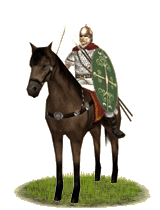 The Thracians field a versatile medium cavalry equipped for both, skirmishing and shock actions. Besides their swords, every rider carries several light javelins to skirmish with the enemy flank guards or simply weaken the formations before the roman infantry engages or the Thracian horsemen charge to finish them. Compared to most Thracian cavalry, the well paid and supplied horsemen serving with our legions are equipped with considerably better gear. Most of their equites wear lorica squamata (scale mail) with iron scales and good quality bronze helmets. Additionally the Thracian fight with a large oval shield, rarely used by most nations cavalrymen. Although this heavy shields are difficult to handle in most combat situations, and limiting the use of the reigns, they have proved their enormous value in battle, by offering a vastly increased defence in close combat as well as against missile fire. Together with other auxiliaries the Thracian horsemen give our legions the much needed effective cavalry support and are a worthy replacement for the roman equites of previous centuries. The Thracians field a versatile medium cavalry equipped for both, skirmishing and shock actions. Besides their swords, every rider carries several light javelins to skirmish with the enemy flank guards or simply weaken the formations before the roman infantry engages or the Thracian horsemen charge to finish them. Compared to most Thracian cavalry, the well paid and supplied horsemen serving with our legions are equipped with considerably better gear. Most of their equites wear lorica squamata (scale mail) with iron scales and good quality bronze helmets. Additionally the Thracian fight with a large oval shield, rarely used by most nations cavalrymen. Although this heavy shields are difficult to handle in most combat situations, and limiting the use of the reigns, they have proved their enormous value in battle, by offering a vastly increased defence in close combat as well as against missile fire. Together with other auxiliaries the Thracian horsemen give our legions the much needed effective cavalry support and are a worthy replacement for the roman equites of previous centuries.
Historically, various auxiliary cavalry completely replaced the Italic contingents in the roman armies of the late republic. During the advanced second century BC, Thrace and most of the Balkan peninsula came under roman dominance, although it stayed an independent client state and did not became a formal province unit 46 AD. In the last century of the republic Thracian contingents, of mostly cavalry, were now often requested when a new roman army was raised and fought with it in campaigns throughout the Mediterranean world, from northern Africa to Asia and the Balkans.
Later, in the early Principate the Thracians had to supply the imperial army directly with recruits, additionally to the usual contingents sent by the Thracian king that still supported roman operations on the Balkan peninsula. The continuous roman drafts caused some unrest and disturbance throughout Thrace, but despite these troubles the loyalty of the cohorts and alae thracum formed with these men remained unquestioned, and the Thracian soldiers in the auxilia made a far greater part of it than the their actual percentage of the empire's population should expect. Probably through this recruitment practice the Thracian units still received the bulk of their replacements still from their homeland when the majority of auxiliary soldiers was already recruited in their area of operation, after they too changed to mainly local recruitment a few decades later in the first century AD. Allied and subdued states and tribes always had to supply the roman army with troops. Almost at all times at least 50% of Roma's soldiers were non citizens. During the first centuries of the republic the old alae of the Italic socii were organized and equipped in a similar way than the roman legions, but around the beginning of the 1st century BC the situation changed. After the social war almost all free people of Italia received roman citizenship and could now be recruited into the regular legions. In the decades after the "marian reforms" the roman light infantry disappeared. The ordo equester, since decades unable to provide a sufficient number of cavalry for the many wars the late republic had to fight, had split off in two main groups. A mainly political elite that filled out the numerous officer and administrative posts the ever growing Res Publica had to offer, and a pure economical elite, the large majority of the Roman and Italic equestrians.The various different peoples now ruled by the republic were a much more inhomogeneous group than the former Italic socii. Depending on their relative military strengths, they had to supply the roman army with the various troop types needed, besides heavy infantry, to be competitive on the battlefield. Most of these troops were levied in the surrounding areas under roman control prior to a campaigns and only large scaled or well prepared wars demanded additional forces and specialised units from distant areas of the roman world. Many of the auxiliaries fought under their own chieftains and officers, while others, especially those recruited from regular provinces, were commanded by roman officers and even organized in roman manner. Usually the auxiliary units were disbanded and sent home after the end of a conflict. However in the continuous wars in last decades of the republic many served that long aside the legions and fought for their generals that they were largely Romanized in the mean time.
Eqvites Hispanorvm (Hispanic Auxiliary Cavalry)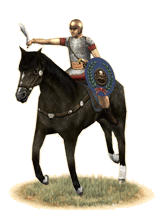 Equites Hispanorum are a versatile medium cavalry equipped for skirmishing and close combat. The tribes of Iberia have strong equestrian traditions and their breeds are famed in many countries. Usually every rider carries multiple light javelins and a fine Iberian falcata sword for close combat, while riding a excellently trained horse. The horsemen recruited in our provinces are comparably well protected and prepared to fight the enemy even in a prolonged melee. Each eques defensive gear consists of a good quality bascinet type bronze helmet, the widely used caetra round shield and a shirt of lorica hamata (chain mail). Hispanic cavalry can ride down skirmishers, protect the flanks of the infantry, prepare their attack with their javelins or skirmish with the enemy's light troops, while they are always capable to charge at the right opportunity. The Spanish auxiliary cavalrymen are trained to form the cantabrian circle, the famous javelin attack formation named after one of their tribes credited with it's invention, which allows the cavalrymen to stay mobile while providing a concentrated continuous missile fire against a single point at the enemy formation. However the Equites Hispanorum are still medium cavalry and a supporting force, it should never be expected that they alone can win a battle. Equites Hispanorum are a versatile medium cavalry equipped for skirmishing and close combat. The tribes of Iberia have strong equestrian traditions and their breeds are famed in many countries. Usually every rider carries multiple light javelins and a fine Iberian falcata sword for close combat, while riding a excellently trained horse. The horsemen recruited in our provinces are comparably well protected and prepared to fight the enemy even in a prolonged melee. Each eques defensive gear consists of a good quality bascinet type bronze helmet, the widely used caetra round shield and a shirt of lorica hamata (chain mail). Hispanic cavalry can ride down skirmishers, protect the flanks of the infantry, prepare their attack with their javelins or skirmish with the enemy's light troops, while they are always capable to charge at the right opportunity. The Spanish auxiliary cavalrymen are trained to form the cantabrian circle, the famous javelin attack formation named after one of their tribes credited with it's invention, which allows the cavalrymen to stay mobile while providing a concentrated continuous missile fire against a single point at the enemy formation. However the Equites Hispanorum are still medium cavalry and a supporting force, it should never be expected that they alone can win a battle.
Historically, various auxiliary cavalry completely replaced the Italic contingents in the roman armies of the late republic. During the Punic wars and the roman expansion into the Iberian peninsula Hispanic cavalry quickly earned an outstanding reputation and many Romans considered them to be the best in the western world. After the conquest of Hispania they were commonly employed by the armies of the republic in campaigns throughout the Mediterranean. In the early Principate the finally pacified Spanish provinces only surpassed by Gaul, remained a main source of recruits for the imperial cavalry, while Celtic and Iberian tactics, fighting style and vocabulary remained dominant well into the 2nd century AD, when the major recruitment areas for cavalrymen had shifted to the frontier provinces since many decades. Allied and subdued states and tribes always had to supply the roman army with troops. Almost at all times at least 50% of Roma's soldiers were non citizens. During the first centuries of the republic the old alae of the Italic socii were organized and equipped in a similar way than the roman legions, but around the beginning of the 1st century BC the situation changed. After the social war almost all free people of Italia received roman citizenship and could now be recruited into the regular legions. In the decades after the "marian reforms" the roman light infantry disappeared. The ordo equester, since decades unable to provide a sufficient number of cavalry for the many wars the late republic had to fight, had split off in two main groups. A mainly political elite that filled out the numerous officer and administrative posts the ever growing Res Publica had to offer, and a pure economical elite, the large majority of the Roman and Italic equestrians. The various different peoples now ruled by the republic were a much more inhomogeneous group than the former Italic socii. Depending on their relative military strengths, they had to supply the roman army with the various troop types needed, besides heavy infantry, to be competitive on the battlefield. Most of these troops were levied in the surrounding areas under roman control prior to a campaigns and only large scaled or well prepared wars demanded additional forces and specialised units from distant areas of the roman world. Many of the auxiliaries fought under their own chieftains and officers, while others, especially those recruited from regular provinces, were commanded by roman officers and even organized in roman manner. Usually the auxiliary units were disbanded and sent home after the end of a conflict. However in the continuous wars in last decades of the republic many served that long aside the legions and fought for their generals that they were largely Romanized in the mean time.
Eqvites Germanorvm (Germanic Auxiliary Cavalry)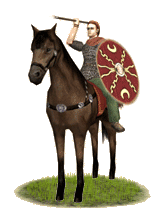 While the majority of Germanics mainly rely on their infantry some tribes are famous for the horsemen and good quality cavalry. Their manoeuvres are surprisingly well executed and the horsemen are taught to fight as a unit even without roman training. The Equites Germanorum in roman service are an excellent light to medium cavalry force, suited to fight in skirmishes as well as shock actions. As most of the other tribal warrior these men are armed with several frame, long spears with a iron tip that can be thrown as well, and a wooden shield but other than ordinary Germanic cavalry the roman auxiliaries are usually also equipped with chain mail shirts and often ride bigger horses of Mediterranean breeds. Thus they can fight at close quarters for an considerably longer time and with much higher chances to succeed. While the majority of Germanics mainly rely on their infantry some tribes are famous for the horsemen and good quality cavalry. Their manoeuvres are surprisingly well executed and the horsemen are taught to fight as a unit even without roman training. The Equites Germanorum in roman service are an excellent light to medium cavalry force, suited to fight in skirmishes as well as shock actions. As most of the other tribal warrior these men are armed with several frame, long spears with a iron tip that can be thrown as well, and a wooden shield but other than ordinary Germanic cavalry the roman auxiliaries are usually also equipped with chain mail shirts and often ride bigger horses of Mediterranean breeds. Thus they can fight at close quarters for an considerably longer time and with much higher chances to succeed.
Historically, the speciality of the Germanic cavalry was to fight together with an equal number of swift picked light infantrymen, that could either support them directly in melee or form a compact body for the riders to retreat. A praxis that was continued in roman service at least into Augustan times when the auxilia, and especially the cavalry, became more standardized and the tribes that permanently stayed under roman rule continuously more Romanized. Germanic cavalry commonly appeared in roman service since their frontier had reached the Rhine during Julius Caesars campaigns in Gaul. While Germanic mounts were generally seen as too small and inadequately trained for cavalry service by the Romans and Germanic horsemen were often reequipped with Iberian and other Mediterranean breeds, the warriors of Germania had a excellent reputation and were especially famed for their loyalty towards their leader. Many of them served in bodyguards of late republican warlords during the decades of civil war and the early emperor were protected by an approximately cohort strong private Germanic guard with a strong mounted component. During it's existence the soldiers of the corporis custodes germani were mostly recruited from the tribes of the Batavians and Ubians, and thus were popularly known as batavi in Roma. After the end of Julio-Claudian dynasty in 68 AD the new emperor Galba finally disbanded the unit. Allied and subdued states and tribes always had to supply the roman army with troops. Almost at all times at least 50% of Roma's soldiers were non citizens. During the first centuries of the republic the old alae of the Italic socii were organized and equipped in a similar way than the roman legions, but around the beginning of the 1st century BC the situation changed. After the social war almost all free people of Italia received roman citizenship and could now be recruited into the regular legions. In the decades after the "marian reforms" the roman light infantry disappeared. The ordo equester, since decades unable to provide a sufficient number of cavalry for the many wars the late republic had to fight, had split off in two main groups. A mainly political elite that filled out the numerous officer and administrative posts the ever growing Res Publica had to offer, and a pure economical elite, the large majority of the Roman and Italic equestrians. The various different peoples now ruled by the republic were a much more inhomogeneous group than the former Italic socii. Depending on their relative military strengths, they had to supply the roman army with the various troop types needed, besides heavy infantry, to be competitive on the battlefield. Most of these troops were levied in the surrounding areas under roman control prior to a campaigns and only large scaled or well prepared wars demanded additional forces and specialised units from distant areas of the roman world. Many of the auxiliaries fought under their own chieftains and officers, while others, especially those recruited from regular provinces, were commanded by roman officers and even organized in roman manner. Usually the auxiliary units were disbanded and sent home after the end of a conflict. However in the continuous wars in last decades of the republic many served that long aside the legions and fought for their generals that they were largely Romanized in the mean time.
Eqvites Gallorvm (Gallic Auxiliary Cavalry)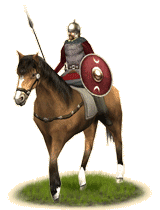 Equites Gallorum are a versatile medium cavalry equipped for both, skirmishing and shock actions. Besides their main lances, every rider carries several light javelins to weaken the enemy formations and some of them also a Celtic long sword for close combat. Other than many of their counterparts from free Celtic tribes the horsemen recruited in our provinces are comparably well protected and better prepared to fight the enemy at close quarters. Each eques defensive gear consists of a good quality bronze helmets, a small round shields and a shirt of lorica hamata (chain mail). Additionally Equites Gallorum now use the four horned saddle, a new and very useful supplementation to cavalry equipment, that enables a firm seat in almost all situations. Drawn from the upper classes of local Celtic societies these are well trained and respected warriors that have become an integral part of many armies of the Res Publica. Together with other auxiliaries they give our legions the much needed effective cavalry support and are a worthy replacement for the roman equites of previous centuries. Gallic cavalry can ride down skirmishers, protect the flanks of the infantry or prepare their attack with their javelins while they are always capable to charge at the right opportunity. However they are still medium cavalry and a supporting force, it should never be expected that they alone can win a battle. Equites Gallorum are a versatile medium cavalry equipped for both, skirmishing and shock actions. Besides their main lances, every rider carries several light javelins to weaken the enemy formations and some of them also a Celtic long sword for close combat. Other than many of their counterparts from free Celtic tribes the horsemen recruited in our provinces are comparably well protected and better prepared to fight the enemy at close quarters. Each eques defensive gear consists of a good quality bronze helmets, a small round shields and a shirt of lorica hamata (chain mail). Additionally Equites Gallorum now use the four horned saddle, a new and very useful supplementation to cavalry equipment, that enables a firm seat in almost all situations. Drawn from the upper classes of local Celtic societies these are well trained and respected warriors that have become an integral part of many armies of the Res Publica. Together with other auxiliaries they give our legions the much needed effective cavalry support and are a worthy replacement for the roman equites of previous centuries. Gallic cavalry can ride down skirmishers, protect the flanks of the infantry or prepare their attack with their javelins while they are always capable to charge at the right opportunity. However they are still medium cavalry and a supporting force, it should never be expected that they alone can win a battle.
Historically, various auxiliary cavalry completely replaced the Italic contingents in the roman armies of the late republic and Celtic horsemen were seen as one of the best in the roman realm. At the time of Julius Caesar they had become the backbone of the army's cavalry arm, fighting with roman forces at places such far away from Gaul as Egypt and Mesopotamia. Celtic and Iberian tactics, fighting style and vocabulary remained dominant in the later regular cavalry arm of the imperial army well into the 2nd century AD, when the major recruitment areas for cavalrymen had shifted to other provinces since many decades. Allied and subdued states and tribes always had to supply the roman army with troops. Almost at all times at least 50% of Roma's soldiers were non citizens. During the first centuries of the republic the old alae of the Italic socii were organized and equipped in a similar way than the roman legions, but around the beginning of the 1st century BC the situation changed. After the social war almost all free people of Italia received roman citizenship and could now be recruited into the regular legions. In the decades after the "marian reforms" the roman light infantry disappeared. The ordo equester, since decades unable to provide a sufficient number of cavalry for the many wars the late republic had to fight, had split off in two main groups. A mainly political elite that filled out the numerous officer and administrative posts the ever growing Res Publica had to offer, and a pure economical elite, the large majority of the Roman and Italic equestrians.The various different peoples now ruled by the republic were a much more inhomogeneous group than the former Italic socii. Depending on their relative military strengths, they had to supply the roman army with the various troop types needed, besides heavy infantry, to be competitive on the battlefield. Most of these troops were levied in the surrounding areas under roman control prior to a campaigns and only large scaled or well prepared wars demanded additional forces and specialised units from distant areas of the roman world. Many of the auxiliaries fought under their own chieftains and officers, while others, especially those recruited from regular provinces, were commanded by roman officers and even organized in roman manner. Usually the auxiliary units were disbanded and sent home after the end of a conflict. However in the continuous wars in last decades of the republic many served that long aside the legions and fought for their generals that they were largely Romanized in the mean time
Imperial
Vigiles (Town Watch)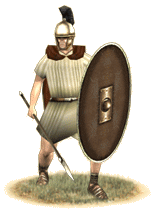 Besides the regions of Italia, that now have collectively gained citizenship, they can be recruited in all fully Romanized provinces of the Imperium Romanum, where great numbers of our citizens have now their home.Vigiles are paramilitary units that mostly act as fire fighters and night watches, and sometimes have additional police duties. Most of them are lightly armed with a spear and a gladius and carry an ovular shield and a bronze Montefortino helmet for protection. With this equipment they can be used as an emergency defence, but these men are not soldiers and they should not be expected to defeat real warriors on even terms. Besides the regions of Italia, that now have collectively gained citizenship, they can be recruited in all fully Romanized provinces of the Imperium Romanum, where great numbers of our citizens have now their home.Vigiles are paramilitary units that mostly act as fire fighters and night watches, and sometimes have additional police duties. Most of them are lightly armed with a spear and a gladius and carry an ovular shield and a bronze Montefortino helmet for protection. With this equipment they can be used as an emergency defence, but these men are not soldiers and they should not be expected to defeat real warriors on even terms.
Historically, Augustus established the lightly armed cohortes vigilum, commanded by the praefectus vigilum, an equestrian officer, in Roma as fire-fighters in the late 1st century BC. They replaced privately organized units of slaves that fulfilled their job since the late republic. The finally seven roughly 500 men strong cohorts oft vigiles mostly consisted of freedmen, and later in 26 AD these received citizenship after six years of service. Every cohort had to take care of two of Roma's 14 districts. They mainly patrolled at night through the streets to look out for unsupervised fires and other unpleasant things. Other cities of all sizes in the empire often had their own small forces of vigiles or similar units. In places with no military garrison they also served as a kind of police, a rare institution in the ancient world.
Cohors Imperatoria (Imperial Legionary Cohort)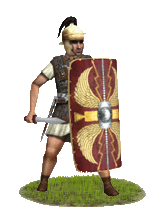 Besides the regions of Italia, they can be recruited in all fully Romanized provinces of the Imperium Romanum, where great numbers of our citizens have now their home. Legionary infantry is still the backbone of the imperial army and it is now easily considered as the most disciplined and most versatile heavy infantry in the world. Their broad training and famous discipline offers them many tactical possibilities in battle, but normally legionaries will fight in the traditional way: throw their pila as soon as the enemy comes in range to soften his formation and then engage at close quarters. While not designed to do so, the pilum can be used like a normal spear as well to make it possible for the legionaries to defend themselves more readily against heavy cavalry attacks. The legion's high quality equipment has become one of the great strengths of the Roman infantry, besides their strict discipline. Most legionnaires are now equipped with Coolus bronze helmets, shirts of lorica hamata or squamata (chain or scale mail) as main body armour and a half ovular scutum, slightly lighter than old republican oval type, while being armed with a type Mainz gladius, two pila and a short dagger called a pugio. Besides the regions of Italia, they can be recruited in all fully Romanized provinces of the Imperium Romanum, where great numbers of our citizens have now their home. Legionary infantry is still the backbone of the imperial army and it is now easily considered as the most disciplined and most versatile heavy infantry in the world. Their broad training and famous discipline offers them many tactical possibilities in battle, but normally legionaries will fight in the traditional way: throw their pila as soon as the enemy comes in range to soften his formation and then engage at close quarters. While not designed to do so, the pilum can be used like a normal spear as well to make it possible for the legionaries to defend themselves more readily against heavy cavalry attacks. The legion's high quality equipment has become one of the great strengths of the Roman infantry, besides their strict discipline. Most legionnaires are now equipped with Coolus bronze helmets, shirts of lorica hamata or squamata (chain or scale mail) as main body armour and a half ovular scutum, slightly lighter than old republican oval type, while being armed with a type Mainz gladius, two pila and a short dagger called a pugio.
Historically, the citizen legions and their heavy infantry still were the core of the Roman army during the Principate, although their portion of the imperial army's regular soldiers steadily decreased and fell below 50% during the first century AD. They combined the functions of infantry, pioneer and artillery units in them, and besides the ordinary heavy infantrymen experts in siege warfare, construction projects, and other engineering tasks could be found in the ranks of the legion. Each contubernium, the eight men strong basic logistical units of the army, was equipped with tools and valli for the fast construction of field fortifications or other structures, while some of the legionaries were trained to act as skirmishers or missile troops in the case the specialised auxilia units were available. To reduce the legion's vulnerable baggage train and increase the mobility of the troops, the soldiers had to carry as much of their equipment as possible by themselves; nearly 50 Kg, so that the only one mule was needed for each contubernium. As a welcomed side effect this gave these men, combined with their regular training, an unrivalled endurance. The legion of the Principate was divided into nine ordinary cohorts and the elite first cohort, that was of double strength at least since the middle of the first century AD. Each cohort consist of three maniples, still named after the Hastati, Principes and Triarii of the long gone glorious army of the old republic, that are divided into two centuriae of 80 men. Other than in Caesars times the legions of the imperial army are usually up to strength and field approximately 5.500 combatants, including the officers. Despite the size of the imperial legion the organisation had slightly changed again from the post Marian pattern by attaching a small group of 120 horsemen. They mostly operated as scouts and messengers, screened the legion on the march and some of them formed the bodyguard for the legatus legionis, the legions senatorial commander. During the decades of his rule following the end of the civil war, Augustus reformed the imperial army significantly and created a standing army with 28 legions as its core. In many fields a systematic approach replaced the improvisation of the late republican era. Most important was that the auxilia, with its indispensable cavalry and archer units, became a regular arm of the professional army and its second base. The length of service for all soldiers was finally set to 26 years for fleet soldiers, 25 years for soldiers of the auxilia, 20 years for legionaries, and 16 years for praetorians. After their discharge they received a cash bonus, the praemia militare, or a small piece of land. The veterans from the auxilia and the fleet were rewarded with Roman citizenship, and a diploma to prove it. Also, medical treatment was improved and all units were now supplied with physicians.
Cohors Praetoriana (Cohort of the Imperial Praetorian Guard)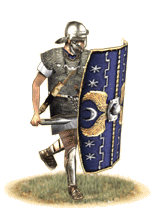 New Praetorians can only be trained in their garrisons in Latium, the Empire's heart, where they protect Roma, the seat of the imperial government. The Cohortes Praetoriae are the highest ranked units in the whole imperial army. Their infantry is the core of the Emperor's Guard in Roma and is considered the best in the empire. Praetorians are equipped as, and fight in, the same manner as the normal legionaries, but their look is often somewhat more magnificent. Their lack of experience in actual combat is compensated by excellent, continuous training, and capable officers. High quality equipment has become one of the great strengths of the Roman heavy infantry, besides their strict discipline. The soldiers of the cohortes praetoriae wear coats of lorica hamata, greaves on both legs, imperial Gallic iron helmets and half ovalur scuta for protection. Their weapons, the same as in contemporary legions, are a type mainz gladius, two pila and a short dagger called the pugio. New Praetorians can only be trained in their garrisons in Latium, the Empire's heart, where they protect Roma, the seat of the imperial government. The Cohortes Praetoriae are the highest ranked units in the whole imperial army. Their infantry is the core of the Emperor's Guard in Roma and is considered the best in the empire. Praetorians are equipped as, and fight in, the same manner as the normal legionaries, but their look is often somewhat more magnificent. Their lack of experience in actual combat is compensated by excellent, continuous training, and capable officers. High quality equipment has become one of the great strengths of the Roman heavy infantry, besides their strict discipline. The soldiers of the cohortes praetoriae wear coats of lorica hamata, greaves on both legs, imperial Gallic iron helmets and half ovalur scuta for protection. Their weapons, the same as in contemporary legions, are a type mainz gladius, two pila and a short dagger called the pugio.
Historically, generals in the late republic began to form cohorts of elite legionaries for their own protection, and as an elite tactical reserve. They were called praetorians for guarding the "Praetorium", the tent or house of a Roman Army's commanding officer. After the civil war Augustus reformed his praetorians into a permanent guard with nine cohorts of 500 infantry and 90 cavalry. Each of them was organized independently and commanded by an equestrian tribune. Three were stationed in Roma, the others in surrounding towns in Latium and Umbria. In the early Principate, Praetorians were mostly recruited in central Italy and had to serve 16 years under excellent conditions and better pay compared to the frontier legions. After their discharge they received a high cash bonus, the praemia militare, or a small piece of land. Later, during Augustus' reign, the praetorian guard was commanded by two, and finally one praefect of equestrian rank, soon one of the most powerful men in the empire. In 23 AD, Tiberius, influenced by his praetorian prefect Seianus, concentrated all cohorts in a single fort in Roma on the Viminal hill.
Eqvites Praetoriani (Cavalry of the Imperial Praetorian Guard)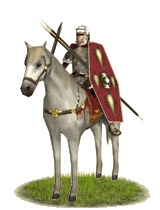 New Praetorians can only be trained in their garrisons in Latium, the Empire's heart, where they protect Roma, the seat of the imperial government.The Cohortes Praetoriae are the highest ranked units in the whole imperial army. The equites praetoriani are their attached cavalry arm. They are equipped and fight in the same way as normal units of the auxilia. Their riders wear scale or chain mail shirts, iron helmets and long hexagonal shields for protection, while everyone is armed with a either type Mainz gladius or Celtic style long sword, ancestors of the spatha, the first real roman cavalry sword, a hasta lance and several iacula, light javelins. Like most of the roman cavalry units they use the famous four horned saddle, which enables a firm seat in almost all occasions. In the field the equites praetoriani often proved to be an efficient force. Their lack of experience in actual combat is largely compensated by excellent continuous training and capable officers. New Praetorians can only be trained in their garrisons in Latium, the Empire's heart, where they protect Roma, the seat of the imperial government.The Cohortes Praetoriae are the highest ranked units in the whole imperial army. The equites praetoriani are their attached cavalry arm. They are equipped and fight in the same way as normal units of the auxilia. Their riders wear scale or chain mail shirts, iron helmets and long hexagonal shields for protection, while everyone is armed with a either type Mainz gladius or Celtic style long sword, ancestors of the spatha, the first real roman cavalry sword, a hasta lance and several iacula, light javelins. Like most of the roman cavalry units they use the famous four horned saddle, which enables a firm seat in almost all occasions. In the field the equites praetoriani often proved to be an efficient force. Their lack of experience in actual combat is largely compensated by excellent continuous training and capable officers.
Historically Augustus added cavalry to the praetorian guard to improve its overall usefulness as an all-round fighting force. Unlike their infantry counterparts, most emperors did not rely on the equites praetoriani alone and most times strong independent horse guards coexisted with them - units such as the corpus germanis custodes until 68 AD and the equites singulares augusti from the 90's onwards. In the late republic generals begun to form cohorts of elite legionaries for their own protection and as an elite tactical reserve. They were called praetorians for guarding the "Praetorium", the tent or house of a Roman Army's commanding officer. After the civil war Augustus reformed his praetorians into a permanent guard with nine cohorts of 500 infantry and approximately 90 cavalry. In campaigns the cavalry of the cohorts was often concentrated and operated independently as a single unit. Each of the cohorts was organized independently and commanded by an equestrian tribune. Three were stationed in Roma, the others in surrounding towns in Latium and Umbria. In the early Principate, Praetorians were mostly recruited in central Italy and had to serve 16 years under excellent conditions and better pay compared to the frontier legions. After their discharge they received a high cash bonus, the praemia militare or a small piece of land. Later during Augustus reign the praetorian guard was commanded by two and eventually one praefect of equestrian rank, who soon thereafter became one of the most powerful man in the empire. In 23 AD Tiberius, influenced by his praetorian prefect Seianus, concentrated all cohorts in a single fort in Roma on the Viminal hill.
Ala Imperatoria (Imperial Cavalry Wing)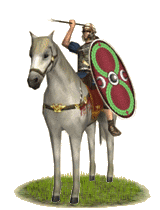 New auxiliary cavalry wings can be formed in all provinces of the Imperium Romanum, where the local population is practicing horse breeding and riding in a degree to support such a move. The alae of the auxilia are the imperial army's first rate cavalry units. Their riders wear lorica hamata (chain mail) or lorica squamata (scale) armour, iron or bronze helmets and large hexagonal or oval shields for protection, while everyone is armed with a sword, a hasta lance and several iacula, light javelins. The helmets they wear are still from the same type as the legionary infantry's gear, either variants of the Coolus bronze or iron imperial Gallic helmets, and less than optimal for cavalry warfare. Especially the large neck guards can be disastrous if the riders falls from his horse. In a few decades, in the first half of the 1st century AD they will be replaced with true cavalry helmets. Narrowly Enclosing nearly the whole head, except the face, they will offer good protection against attacks from all sides in a prolonged cavalry melee. Their swords are either type Mainz gladii or Celtic long swords, ancestors of the spatha, the first real roman cavalry sword. Introduced around the midst of the 1st century AD the fine and well balanced spatha will become the main sword of the cavalry for the remaining centuries of the empire's existence and even replace the gladius as primary infantry weapon in the late roman army. With its two-sided narrow blade the spatha is considerably longer than the gladius and much better suited for the use from horseback. The use of the one handed hasta lance as primary weapon allows the horsemen to handle large shields with their left hand. The hasta's compactness allows it to use the weapon mainly overhand, to stab from above at the enemy besides rarer attacks in the conventional way and even to throw in emergency situations. Like most of the imperial army's cavalry, they use the famous four horned saddle, which enables a firm seat in almost all occasions. The training of the alae is excellent and extensive, their equipment makes them multifunctional. They can weaken enemy formations with javelin showers and than attack with their lances in the very next moment. However this versatility has its price. Their horsemen are comparably lighter armoured than the former Hellenistic cavalry or even the heavy cataphractarii of the east and the hasta is shorter than many of the cavalry lances used by our enemies. The alae should only be used with care against such opponents. New auxiliary cavalry wings can be formed in all provinces of the Imperium Romanum, where the local population is practicing horse breeding and riding in a degree to support such a move. The alae of the auxilia are the imperial army's first rate cavalry units. Their riders wear lorica hamata (chain mail) or lorica squamata (scale) armour, iron or bronze helmets and large hexagonal or oval shields for protection, while everyone is armed with a sword, a hasta lance and several iacula, light javelins. The helmets they wear are still from the same type as the legionary infantry's gear, either variants of the Coolus bronze or iron imperial Gallic helmets, and less than optimal for cavalry warfare. Especially the large neck guards can be disastrous if the riders falls from his horse. In a few decades, in the first half of the 1st century AD they will be replaced with true cavalry helmets. Narrowly Enclosing nearly the whole head, except the face, they will offer good protection against attacks from all sides in a prolonged cavalry melee. Their swords are either type Mainz gladii or Celtic long swords, ancestors of the spatha, the first real roman cavalry sword. Introduced around the midst of the 1st century AD the fine and well balanced spatha will become the main sword of the cavalry for the remaining centuries of the empire's existence and even replace the gladius as primary infantry weapon in the late roman army. With its two-sided narrow blade the spatha is considerably longer than the gladius and much better suited for the use from horseback. The use of the one handed hasta lance as primary weapon allows the horsemen to handle large shields with their left hand. The hasta's compactness allows it to use the weapon mainly overhand, to stab from above at the enemy besides rarer attacks in the conventional way and even to throw in emergency situations. Like most of the imperial army's cavalry, they use the famous four horned saddle, which enables a firm seat in almost all occasions. The training of the alae is excellent and extensive, their equipment makes them multifunctional. They can weaken enemy formations with javelin showers and than attack with their lances in the very next moment. However this versatility has its price. Their horsemen are comparably lighter armoured than the former Hellenistic cavalry or even the heavy cataphractarii of the east and the hasta is shorter than many of the cavalry lances used by our enemies. The alae should only be used with care against such opponents.
Historically, the large majority of the cavalry in roman service in the late republic were irregular auxiliaries of mostly Celtic or Iberian origin and their influence will remain dominant in roman cavalry warfare for the next centuries. Some of this units were already organized and commanded by Romans or served that long aside the legions that they had been largely Romanized in the mean time, while others were still commanded by their own leaders. In the early Principate they become a fully integrated part of the professional imperial army. Their training and equipment was unified and brought to a similar level of quality than in the legions they should cooperate with. The alae (ala/ lat. wing) received their name for the cavalries natural position in a battle formation, the flanks. These units had an excellent reputation in the imperial army and were ranked highest among the auxilia. Later it was not uncommon for exceptional horsemen from the legions to be transferred to an ala. Normally one or later mostly two of them cooperated with each legion during campaigns and together they formed the core of the Principate's armies. The 4th century military theorist Vegetius reported that only for ala and legionary first cohorts units a minimum height requirement of at best six (1,77m) or at least 5,5 roman feet (1,62m) had existed. The standard ala quingenaria of the early Principate consisted of 16 turmae with 32 men and was armed as above. However after almost a century of warfare in the east some were already equipped as horse archers. Later in the second half of the 1st century AD elite ala millaria with 24, approximately 40 men strong, turmae will be formed and in the early 2nd century units of catafractarii and contarii will appear under the increasing influence of Parthians and Sarmatians on the development of roman cavalry. Most alae were named after the ethnicity of the original recruits and kept their name even if they were transferred to other parts of the empire where they immediately begun to recruit locals as replacement. During the decades of his rule following the end of the civil war, Augustus reformed the imperial army significantly and created a standing army with 28 legions as its core. In many fields a systematic approach replaced the improvisation of the late republican era. Most important was that the auxilia, with its indispensable cavalry and archer units, became a regular arm of the professional army and its second base. Their soldiers were equipped in the Roman fashion, and well commanded first by proven Centurions, transferred from the legions and later by a corps of equestrian officers. They were mostly recruited from amongst the peregrines, free provincials without roman citizenship, who either volunteered for service or accepted a draft into it. However, the transformation of the auxilia did not happen over night and the irregular contingents of soldiers supplied by allied tribes and vassal states did not disappear all at once. While the large majority of the cavalry units were reorganized during Augustus reign, the infantry followed much more slowly, lingering in the old fashions until the later years of the 1st century AD. The length of service for all soldiers was finally set to 26 years for fleet soldiers, 25 years for soldiers of the auxilia, 20 years for legionaries, and 16 years for praetorians. After their discharge they received a cash bonus, the praemia militare, or a small piece of land. The veterans from the auxilia and the fleet were rewarded with Roman citizenship, and a diploma to prove it. Also, medical treatment was improved and all units were now supplied with physicians.
Eqvites Singvlares (Picked General's Guard Cavalry)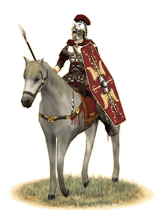 Equites Singulares are provincial horse guards formed with the best horsemen a regional army has to offer and accompany their commanders into battle. These units are mostly equipped and fight in the manner as normal Roman cavalry. However sometimes better or additional armour, such as greaves, is worn, that is most times even more highly elaborated than in the ordinary Alae. Besides their body armour the horsemen of the equites singulares, wear iron helmets and long oval or hexagonal shields for protection, while every rider is armed with a either type Mainz gladius or Celtic style long sword, ancestors of the spatha, the first real roman cavalry sword, a hasta lance and several iacula, light javelins. Like most of the imperial army's cavalry, they use the famous four horned saddle, which enables a firm seat in almost all occasions. In battle the equites singulares often proved to be one of the most powerful units. When a capable general leads them personally they can turn the fight in critical moments. Equites Singulares are provincial horse guards formed with the best horsemen a regional army has to offer and accompany their commanders into battle. These units are mostly equipped and fight in the manner as normal Roman cavalry. However sometimes better or additional armour, such as greaves, is worn, that is most times even more highly elaborated than in the ordinary Alae. Besides their body armour the horsemen of the equites singulares, wear iron helmets and long oval or hexagonal shields for protection, while every rider is armed with a either type Mainz gladius or Celtic style long sword, ancestors of the spatha, the first real roman cavalry sword, a hasta lance and several iacula, light javelins. Like most of the imperial army's cavalry, they use the famous four horned saddle, which enables a firm seat in almost all occasions. In battle the equites singulares often proved to be one of the most powerful units. When a capable general leads them personally they can turn the fight in critical moments.
Historically, from the early Principate onwards, imperial governors, who normally also commanded all the military stationed in their province, were protected by their own horse guards, mostly raised from the regular alae units in the local army. Contrary to the men selected for the later equites singulares augusti, these picked horsemen remained in the lists of their original units and were only temporary transferred to the guards. During the decades of his rule following the end of the civil war, Augustus reformed the imperial army significantly and created a standing army with 28 legions as its core. In many fields a systematic approach replaced the improvisation of the late republican era. Most important was that the auxilia, with its indispensable cavalry and archer units, became a regular arm of the professional army and its second base. Trained to the same high standards of the legions they should cooperate with, these excellent soldiers were equipped in the Roman fashion, and well commanded first by proven Centurions, transferred from the legions, and later by a corps of equestrian officers. Their soldiers were mostly recruited from amongst the peregrines, free provincials without roman citizenship, who either volunteered for service or accepted a draft into it. However, the transformation of the auxilia did not happen over night and the irregular contingents of soldiers supplied by allied tribes and vassal states did not disappear all at once. While the large majority of the alae (pure cavalry units where the need for regular forces was more urgent) were reorganized during Augustus reign, the infantry followed much more slowly, lingering in the old fashions until the later years of the 1st century AD. The length of service for all soldiers was finally set to 26 years for fleet soldiers, 25 years for soldiers of the auxilia, 20 years for legionaries, and 16 years for praetorians. After their discharge they received a cash bonus, the praemia militare, or a small piece of land. The veterans from the auxilia and the fleet were rewarded with Roman citizenship, and a diploma to prove it. Also, medical treatment was improved and all units were now supplied with physicians.
Cohors Validvm Avxiliarivm (Imperial Heavy Auxiliary Infantry Cohort)-Western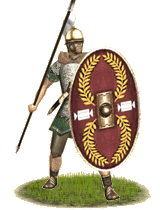 Soldiers for the auxiliary cohorts can be drafted into the army in all provinces of the Imperium Romanum. Auxiliary infantry is a cheaper supplement of the legionary troops and a good way to better participate the provinces at the huge burdens of the empire to defend it's people. The soldiers of most of these cohorts fight as heavy spearmen in close formation similar to the legionary infantry, but without the tactical flexibility offered by their larger scutum and the pilum. However other than the pilum the hasta, commonly used by the auxiliaries, is a true thrusting spear and as such a better defence against cavalry attacks. Other than the hasta they are equipped with the gladius, long flat mostly oval shields and well protected by shirts of lorica hamata (chain mail) and old style bronze montefortino helmets, often out phased from the legions. Soldiers for the auxiliary cohorts can be drafted into the army in all provinces of the Imperium Romanum. Auxiliary infantry is a cheaper supplement of the legionary troops and a good way to better participate the provinces at the huge burdens of the empire to defend it's people. The soldiers of most of these cohorts fight as heavy spearmen in close formation similar to the legionary infantry, but without the tactical flexibility offered by their larger scutum and the pilum. However other than the pilum the hasta, commonly used by the auxiliaries, is a true thrusting spear and as such a better defence against cavalry attacks. Other than the hasta they are equipped with the gladius, long flat mostly oval shields and well protected by shirts of lorica hamata (chain mail) and old style bronze montefortino helmets, often out phased from the legions.
Historically, after his final victory in the civil war when he formed the standing army of the Principate, Augustus vastly decreased the numbers of legions from over forty to a necessary minimum strength of 28. However to observe and garrison the sheer endless borders of the Imperium Romanum, much more and cheaper troops were needed. Subdued tribes and states always had to supply the Roman army with soldiers and around 50 % of it's soldiers were at all times not Roman citizens. The empire continued this practice. To increase their efficiency and ease the cooperation with other parts of the army most of these troops were organized into cohorts with roman command structure and training. During the following decades of Augustus rule, the imperial army changed significantly. In many fields a systematic approach replaced the improvisation of the late republican era. Most important was that the auxilia, with its indispensable cavalry and archer units, became a regular arm of the professional army and its second base. The ordinary infantry of the auxilia received less pay and their equipment was often of inferior quality than the legionary's. Their cohorts made the bulk of the auxilia and were ranked lowest of all regular units of the imperial army. These infantry units were a cheap supplement to the legionary infantry and relieved them from secondary tasks, as garrison duties, border patrols, the protection of missile troops on the battlefield or to hold less important sections of the battle line. Their soldiers were equipped in the Roman fashion, and well commanded first by proven Centurions, transferred from the legions and later by a corps of equestrian officers. They were now mostly directly recruited from amongst the peregrines, free provincials without roman citizenship, in Romanized areas who either volunteered for service or accepted a draft into it. However, the transformation of the auxilia did not happen over night and the irregular contingents of soldiers supplied by allied tribes and vassal states did not disappear all at once. While the large majority of the alae (pure cavalry units where the need for regular forces was more urgent) were reorganized during Augustus reign, the infantry followed much more slowly, lingering in the old fashions until the later years of the 1st century AD. Most cohorts of the Principate's auxilia were standard sized cohors quingenaria units, consisting of 480 enlisted soldiers organised in six centuriae. Later in the first century elite approximately double strength cohors millaria and mixed cohors equitata appeared. The equitata units had their own attached cavalry contingent of 120 respectively 240 troopers for the millaria version, so that these units could either operate independently without further assistance or provide a more flexible support for the legions in the case of specialised archer units. Normally the cohorts were named after the ethnicity of the original recruits and kept their name even if they were transferred to other parts of the empire where they immediately begun to recruit locals as replacement. The length of service for all soldiers was finally set to 26 years for fleet soldiers, 25 years for soldiers of the auxilia, 20 years for legionaries, and 16 years for praetorians. After their discharge they received a cash bonus, the praemia militare, or a small piece of land. The veterans from the auxilia and the fleet were rewarded with Roman citizenship, and a diploma to prove it. Also, medical treatment was improved and all units were now supplied with physicians.
Cohors Validvm Avxiliarivm (Imperial Heavy Auxiliary Infantry Cohort)-Eastern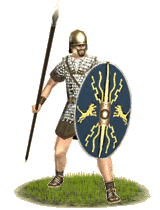 Soldiers for the auxiliary cohorts can be drafted into the army in all provinces of the Imperium Romanum.Auxiliary infantry is a cheaper supplement of the legionary troops and a good way to better participate the provinces at the huge burdens of the empire to defend it's people. The soldiers of most of these cohorts fight as heavy spearmen in close formation similar to the legionary infantry, but without the tactical flexibility offered by their larger scutum and the pilum. However other than the pilum the hasta, commonly used by the auxiliaries, is a true thrusting spear and as such a better defence against cavalry attacks. Other than the hasta they are equipped with the gladius, long flat mostly oval shields and old style bronze montefortino helmets, often out phased from the legions. Greek and Asian soldiers in the east are much less influenced in their appearance by western roman culture than their European comrades. Although used in Europe, the lorica squamata (scale mail) armour is more widely in use among the eastern troops and offers a better protection against arrows than chain mail shirts. Soldiers for the auxiliary cohorts can be drafted into the army in all provinces of the Imperium Romanum.Auxiliary infantry is a cheaper supplement of the legionary troops and a good way to better participate the provinces at the huge burdens of the empire to defend it's people. The soldiers of most of these cohorts fight as heavy spearmen in close formation similar to the legionary infantry, but without the tactical flexibility offered by their larger scutum and the pilum. However other than the pilum the hasta, commonly used by the auxiliaries, is a true thrusting spear and as such a better defence against cavalry attacks. Other than the hasta they are equipped with the gladius, long flat mostly oval shields and old style bronze montefortino helmets, often out phased from the legions. Greek and Asian soldiers in the east are much less influenced in their appearance by western roman culture than their European comrades. Although used in Europe, the lorica squamata (scale mail) armour is more widely in use among the eastern troops and offers a better protection against arrows than chain mail shirts.
Historically, after his final victory in the civil war when he formed the standing army of the Principate, Augustus vastly decreased the numbers of legions from over forty to a necessary minimum strength of 28. However to observe and garrison the sheer endless borders of the Imperium Romanum, much more and cheaper troops were needed. Subdued tribes and states always had to supply the Roman army with soldiers and around 50 % of it's soldiers were at all times not Roman citizens. The empire continued this practice. To increase their efficiency and ease the cooperation with other parts of the army most of these troops were organized into cohorts with roman command structure and training. During the following decades of Augustus rule, the imperial army changed significantly. In many fields a systematic approach replaced the improvisation of the late republican era. Most important was that the auxilia, with its indispensable cavalry and archer units, became a regular arm of the professional army and its second base.The ordinary infantry of the auxilia received less pay and their equipment was often of inferior quality than the legionary's. Their cohorts made the bulk of the auxilia and were ranked lowest of all regular units of the imperial army. These infantry units were a cheap supplement to the legionary infantry and relieved them from secondary tasks, as garrison duties, border patrols, the protection of missile troops on the battlefield or to hold less important sections of the battle line. Their soldiers were equipped in the Roman fashion, and well commanded first by proven Centurions, transferred from the legions and later by a corps of equestrian officers. They were now mostly directly recruited from amongst the peregrines, free provincials without roman citizenship, in Romanized areas who either volunteered for service or accepted a draft into it. However, the transformation of the auxilia did not happen over night and the irregular contingents of soldiers supplied by allied tribes and vassal states did not disappear all at once. While the large majority of the alae (pure cavalry units where the need for regular forces was more urgent) were reorganized during Augustus reign, the infantry followed much more slowly, lingering in the old fashions until the later years of the 1st century AD. Most cohorts of the Principate's auxilia were standard sized cohors quingenaria units, consisting of 480 enlisted soldiers organised in six centuriae. Later in the first century elite approximately double strength cohors millaria and mixed cohors equitata appeared. The equitata units had their own attached cavalry contingent of 120 respectively 240 troopers for the millaria version, so that these units could either operate independently without further assistance or provide a more flexible support for the legions in the case of specialised archer units. Normally the cohorts were named after the ethnicity of the original recruits and kept their name even if they were transferred to other parts of the empire where they immediately begun to recruit locals as replacement. The length of service for all soldiers was finally set to 26 years for fleet soldiers, 25 years for soldiers of the auxilia, 20 years for legionaries, and 16 years for praetorians. After their discharge they received a cash bonus, the praemia militare, or a small piece of land. The veterans from the auxilia and the fleet were rewarded with Roman citizenship, and a diploma to prove it. Also, medical treatment was improved and all units were now supplied with physicians.
Cohors Sagittariorvm Levantinorvm (Imperial Eastern Archer Auxilia)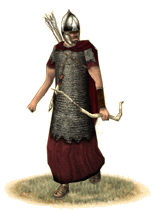 Specialised archer units for the imperial army can be enrolled in all provinces in which skilled bowyers and a population familiar with the traditions of archery can be found. These are mainly in Asia and the fringes of the steppes. Archers now have become an integral part of any well composed roman army. Normally they are placed behind a wall of protective heavy infantry in the battle formation. From there they can provide a supporting barrage fire above the infantry's heads to weaken the enemy and break his charge before the main lines engage. The imperial army's archers are more heavily armoured than their counterparts, with shirts of lorica squamata or hamata (scale or chain mail), conical iron or bronze helmets and small shields protecting their left arm. They use long ranged recurved composite bows with bone ends and bracers to protect their forearms from the sinew, together with multiple types of arrows: three bladed heads to inflict heavy wounds at un armoured targets, thin needle like, pyramidal shaped armour piercing heads and flaming arrows, carrying an ignition load in a kind of small metal cage incorporated into the arrowhead. Additionally the archers are armed with a gladius for self defence, but despite this and their armour it should not be expected that they fight well at close quarters for any longer time. Specialised archer units for the imperial army can be enrolled in all provinces in which skilled bowyers and a population familiar with the traditions of archery can be found. These are mainly in Asia and the fringes of the steppes. Archers now have become an integral part of any well composed roman army. Normally they are placed behind a wall of protective heavy infantry in the battle formation. From there they can provide a supporting barrage fire above the infantry's heads to weaken the enemy and break his charge before the main lines engage. The imperial army's archers are more heavily armoured than their counterparts, with shirts of lorica squamata or hamata (scale or chain mail), conical iron or bronze helmets and small shields protecting their left arm. They use long ranged recurved composite bows with bone ends and bracers to protect their forearms from the sinew, together with multiple types of arrows: three bladed heads to inflict heavy wounds at un armoured targets, thin needle like, pyramidal shaped armour piercing heads and flaming arrows, carrying an ignition load in a kind of small metal cage incorporated into the arrowhead. Additionally the archers are armed with a gladius for self defence, but despite this and their armour it should not be expected that they fight well at close quarters for any longer time.
Historically, the majority of the specialised archer and horse archer units of the imperial roman army were enrolled in the eastern provinces, especially in Syria, where fine archery skills and the knowledge to make powerful composite bows were backed by traditions that can be dated back well into the bronze age. After their formation these troops could be sent to all parts of the empire, where they often begun to recruit locals as replacement. Other than most units of the auxilia, however the specialised archer alae and cohorts still received the bulk of their replacement from their home area. Most of these units were stationed in northern Africa, the lower Danubian Provinces and the east where highly mobile enemies threatened the empires borders. During the decades of his rule following the end of the civil war, Augustus reformed the imperial army significantly and created a standing army with 28 legions as its core. In many fields a systematic approach replaced the improvisation of the late republican era. Most important was that the auxilia, with its indispensable cavalry and archer units, became a regular arm of the professional army and its second base. Trained to the same high standards of the legions they should cooperate with, these excellent soldiers were equipped in the Roman fashion, and well commanded first by proven Centurions, transferred from the legions, and later by a corps of equestrian officers. Their soldiers were mostly recruited from amongst the peregrines, free provincials without roman citizenship, who either volunteered for service or accepted a draft into it. However, the transformation of the auxilia did not happen over night and the irregular contingents of soldiers supplied by allied tribes and vassal states did not disappear all at once. While the large majority of the alae (pure cavalry units where the need for regular forces was more urgent) were reorganized during Augustus reign, the infantry followed much more slowly, lingering in the old fashions until the later years of the 1st century AD. Most cohorts of the Principate's auxilia were standard sized cohors quingenaria units, consisting of 480 enlisted soldiers organised in six centuriae. Later in the first century elite approximately double strength cohors millaria and mixed cohors equitata appeared. The equitata units had their own attached cavalry contingent of 120 respectively 240 troopers for the millaria version, so that these units could either operate independently without further assistance or provide a more flexible support for the legions in the case of specialised archer units. The length of service for all soldiers was finally set to 26 years for fleet soldiers, 25 years for soldiers of the auxilia, 20 years for legionaries, and 16 years for praetorians. After their discharge they received a cash bonus, the praemia militare, or a small piece of land. The veterans from the auxilia and the fleet were rewarded with Roman citizenship, and a diploma to prove it. Also, medical treatment was improved and all units were now supplied with physicians.
|
 |
|
 |






















|